Full text
PDF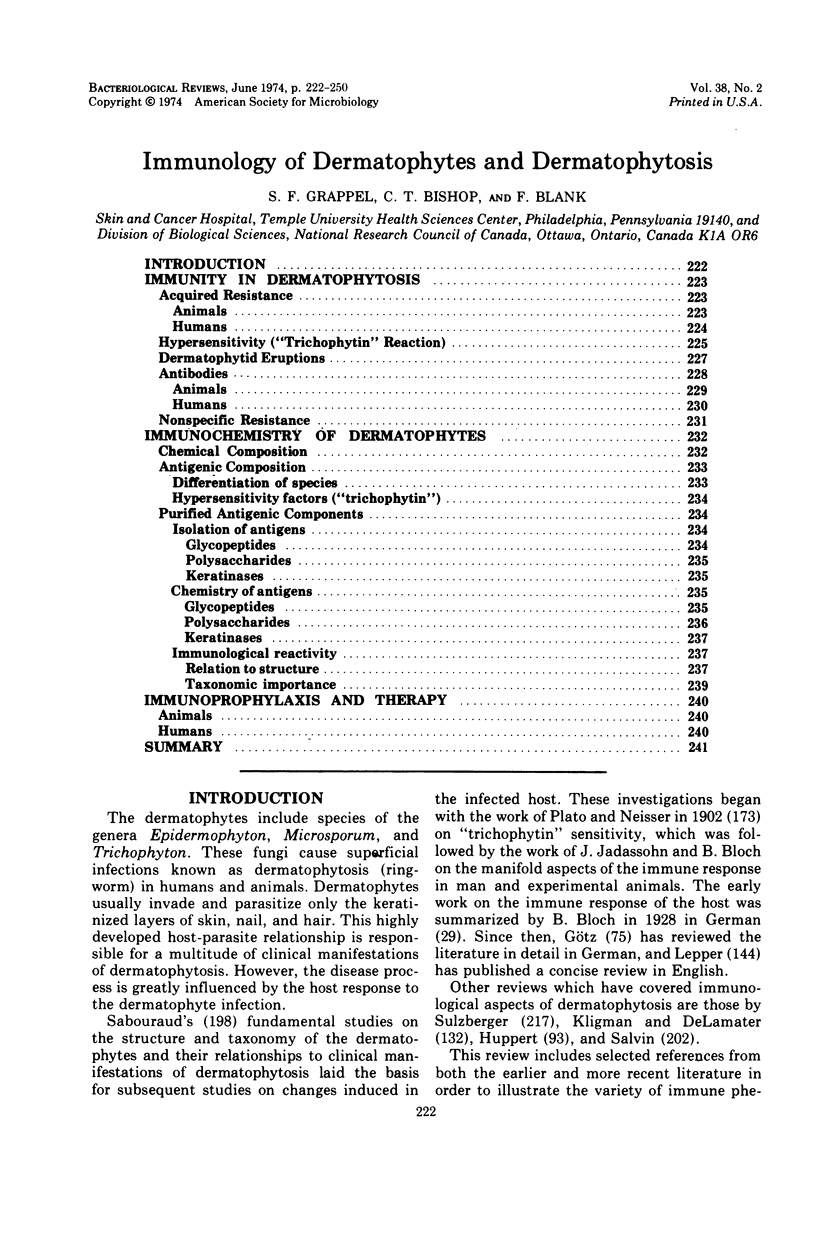
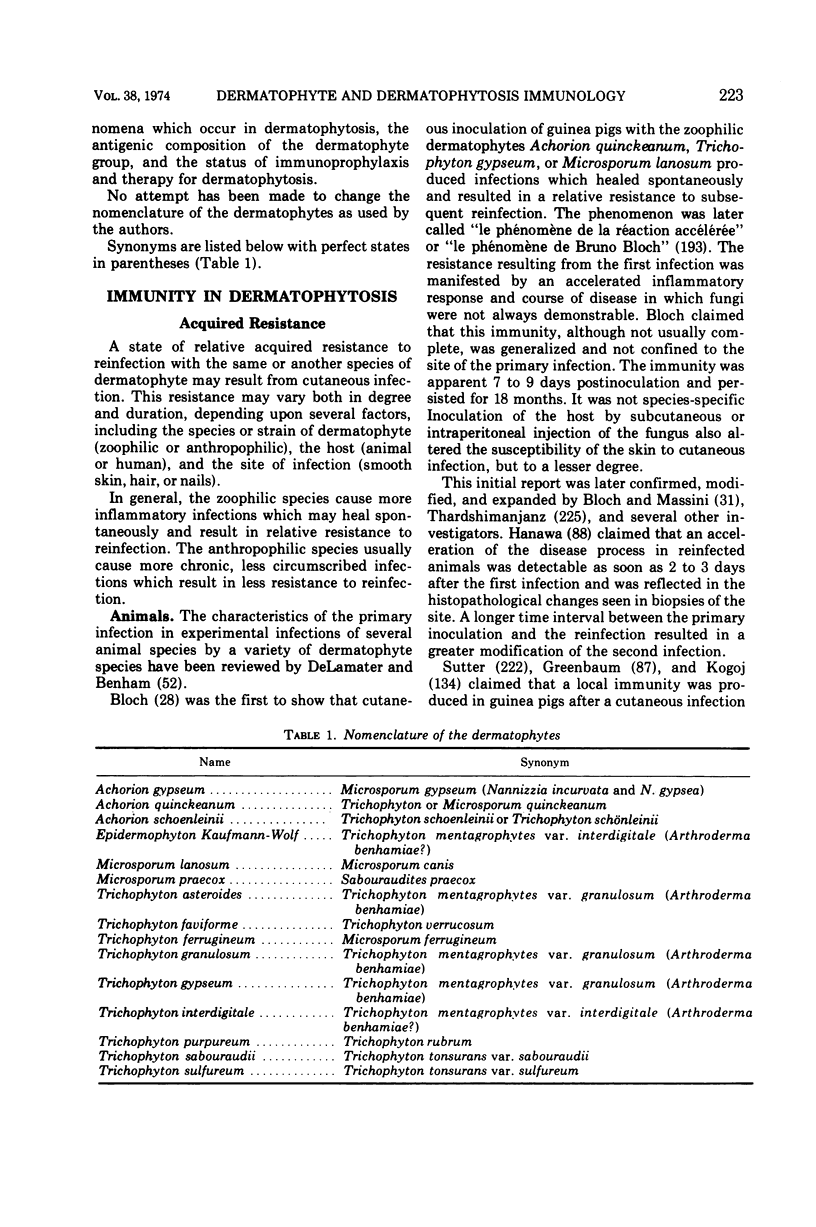
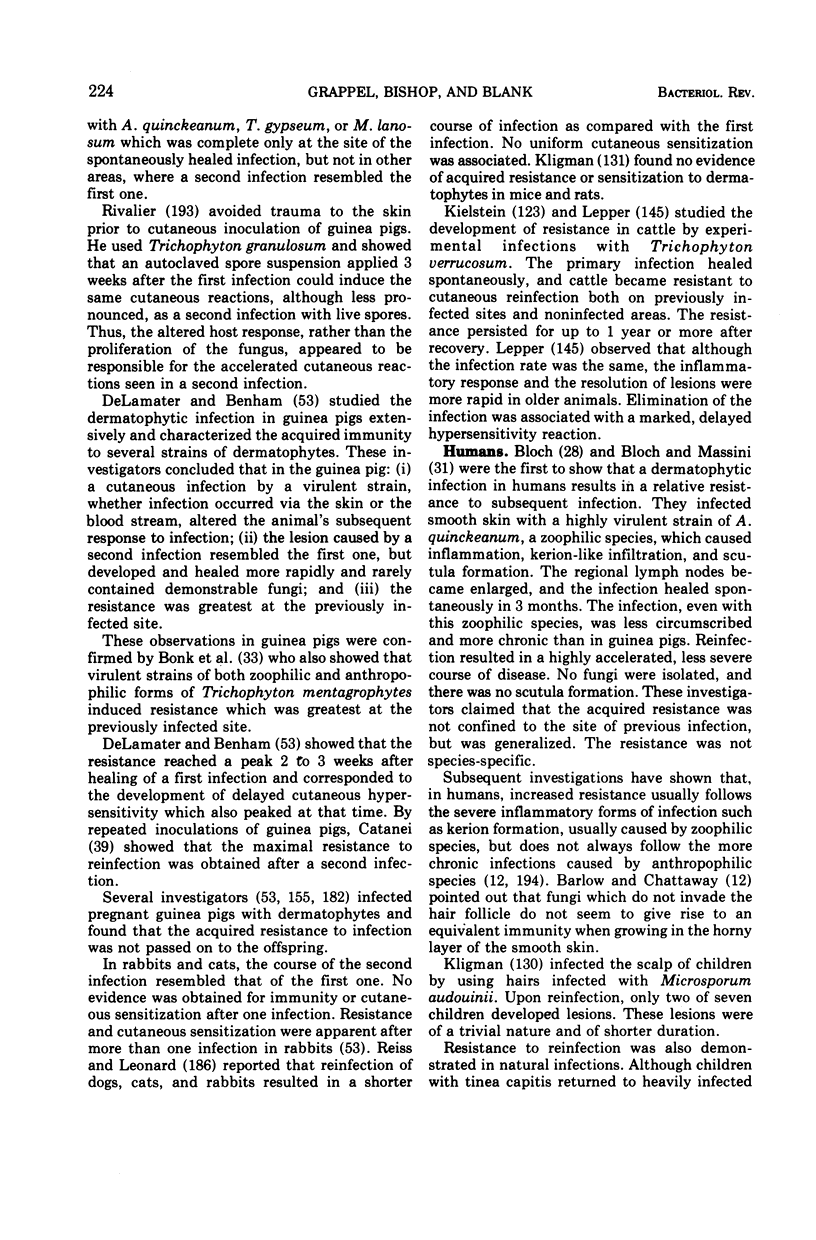
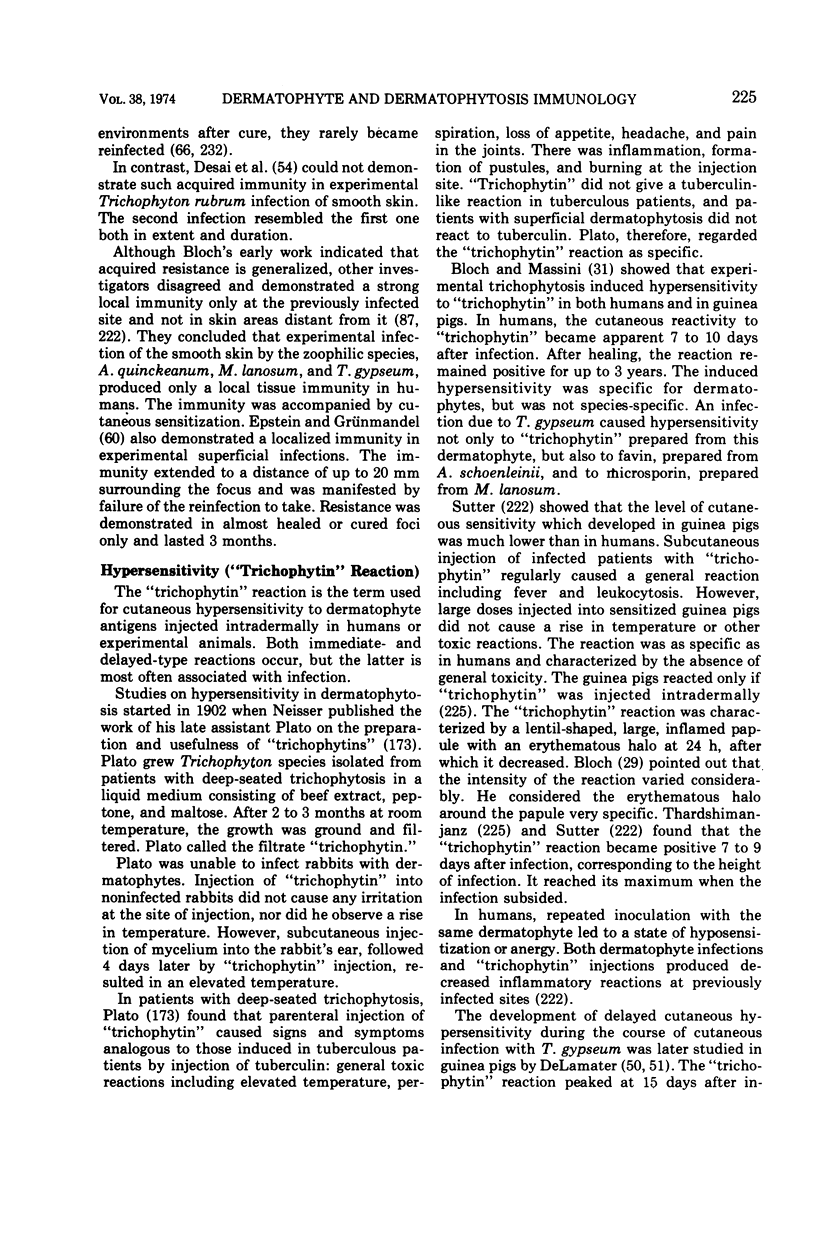
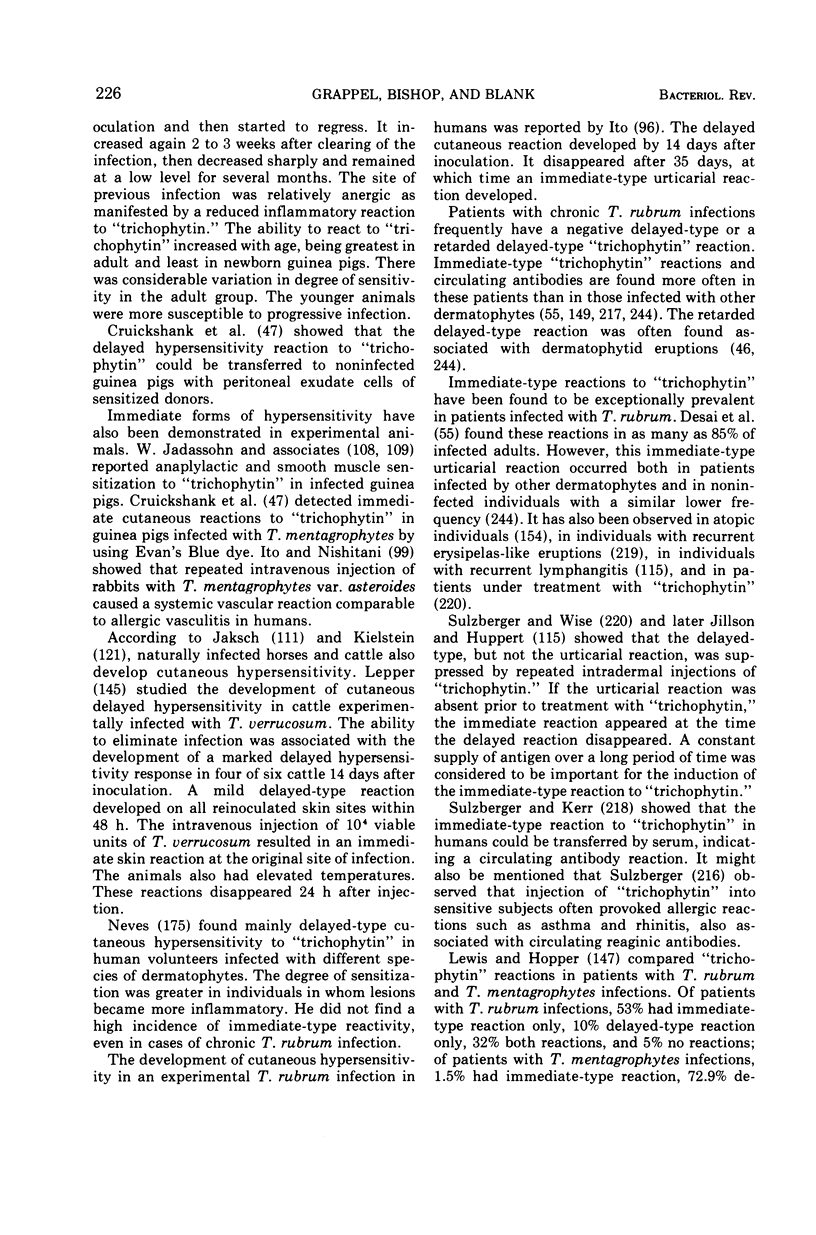
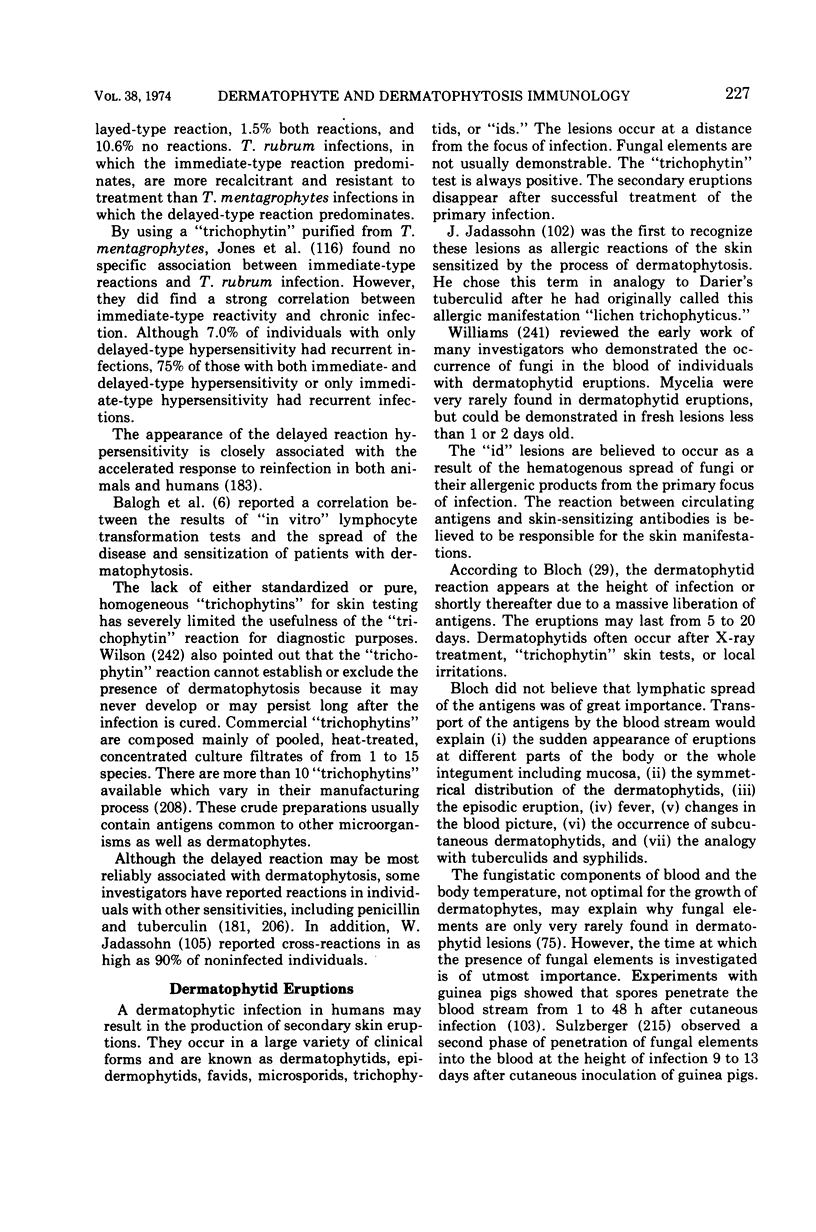
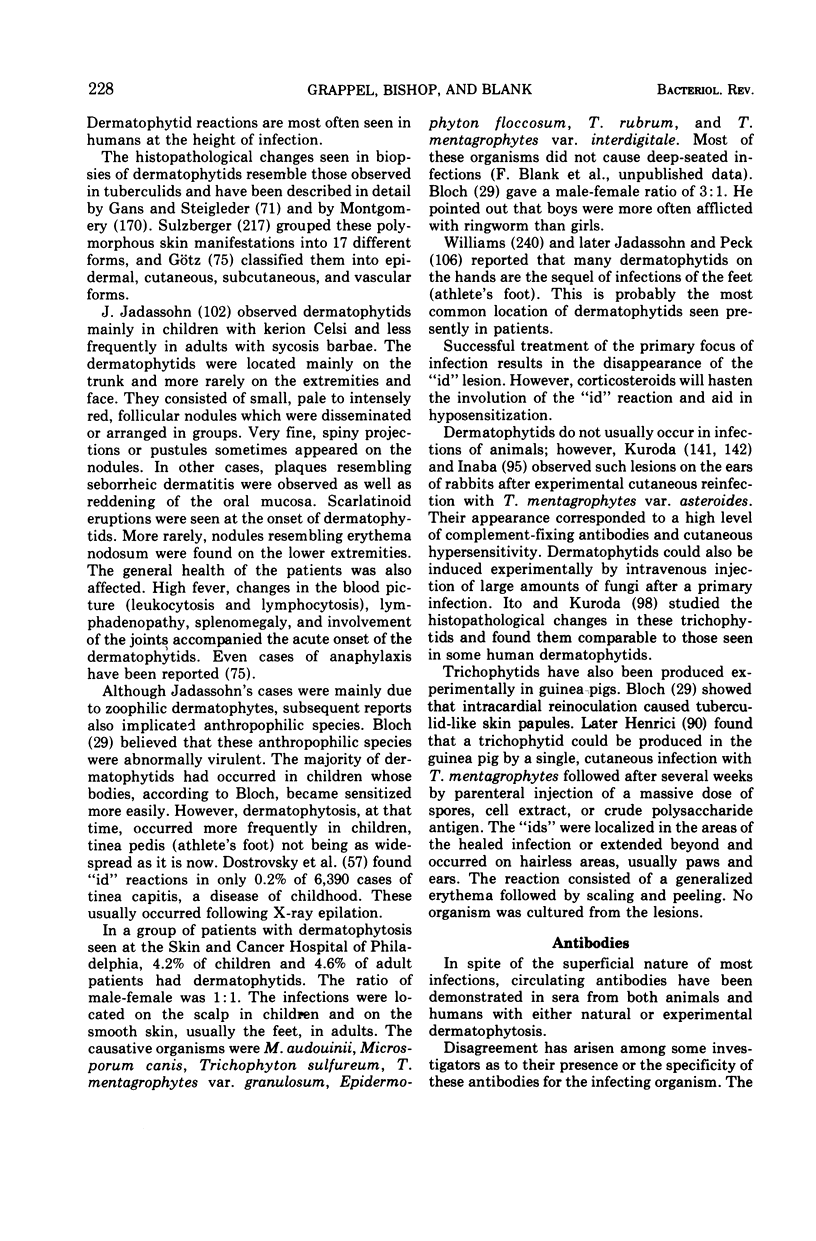
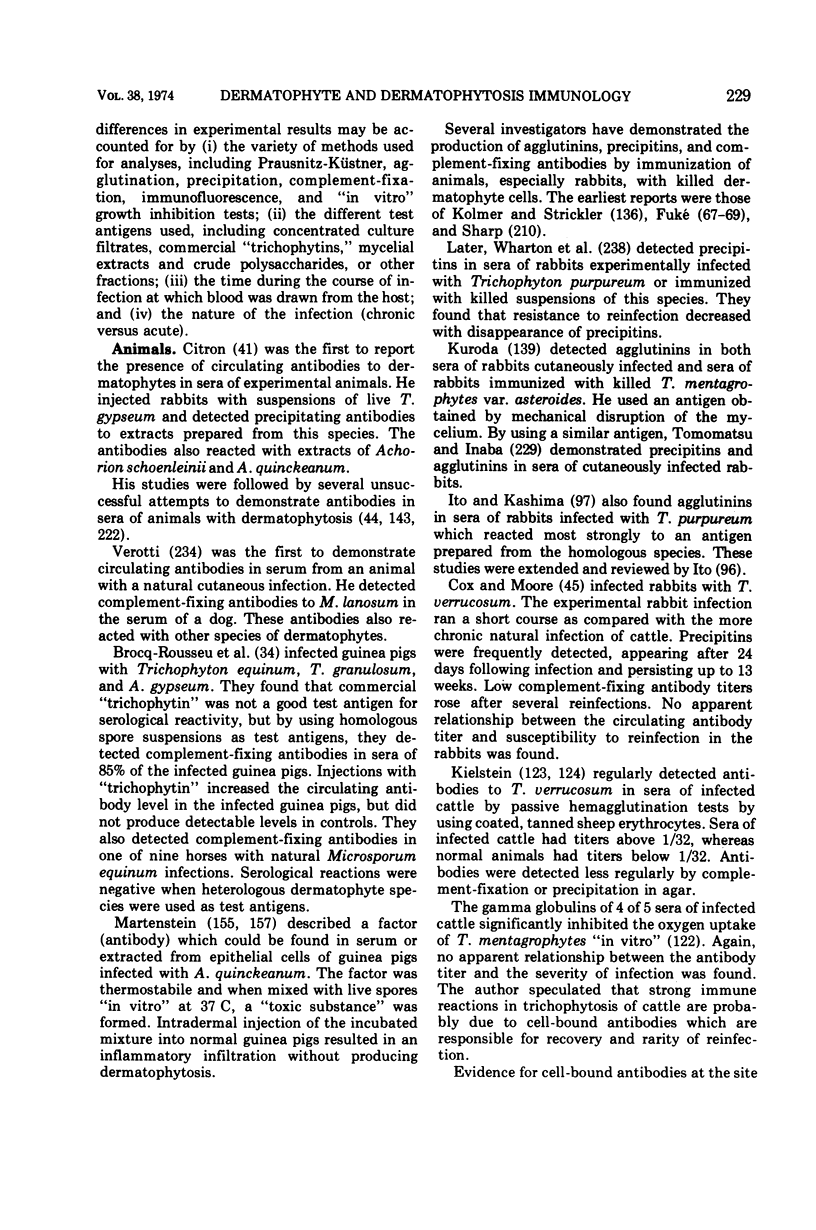
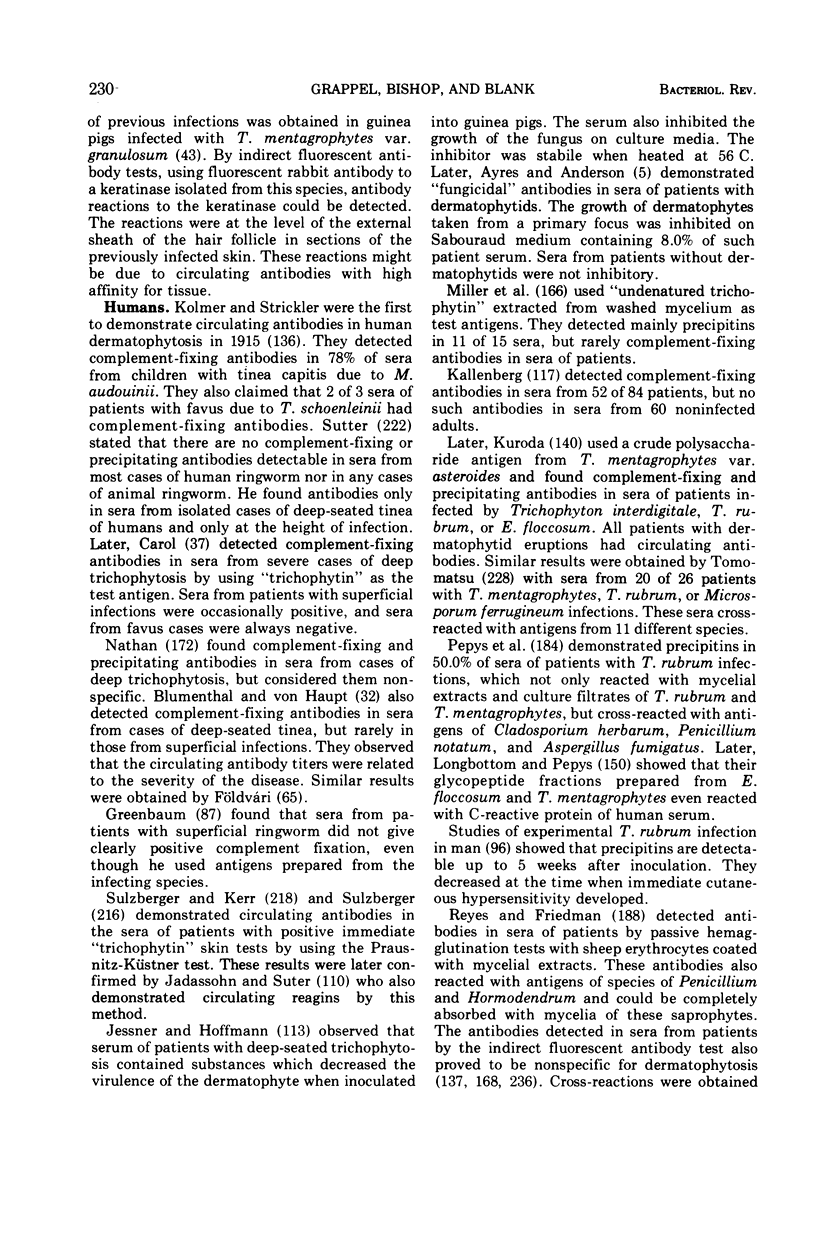
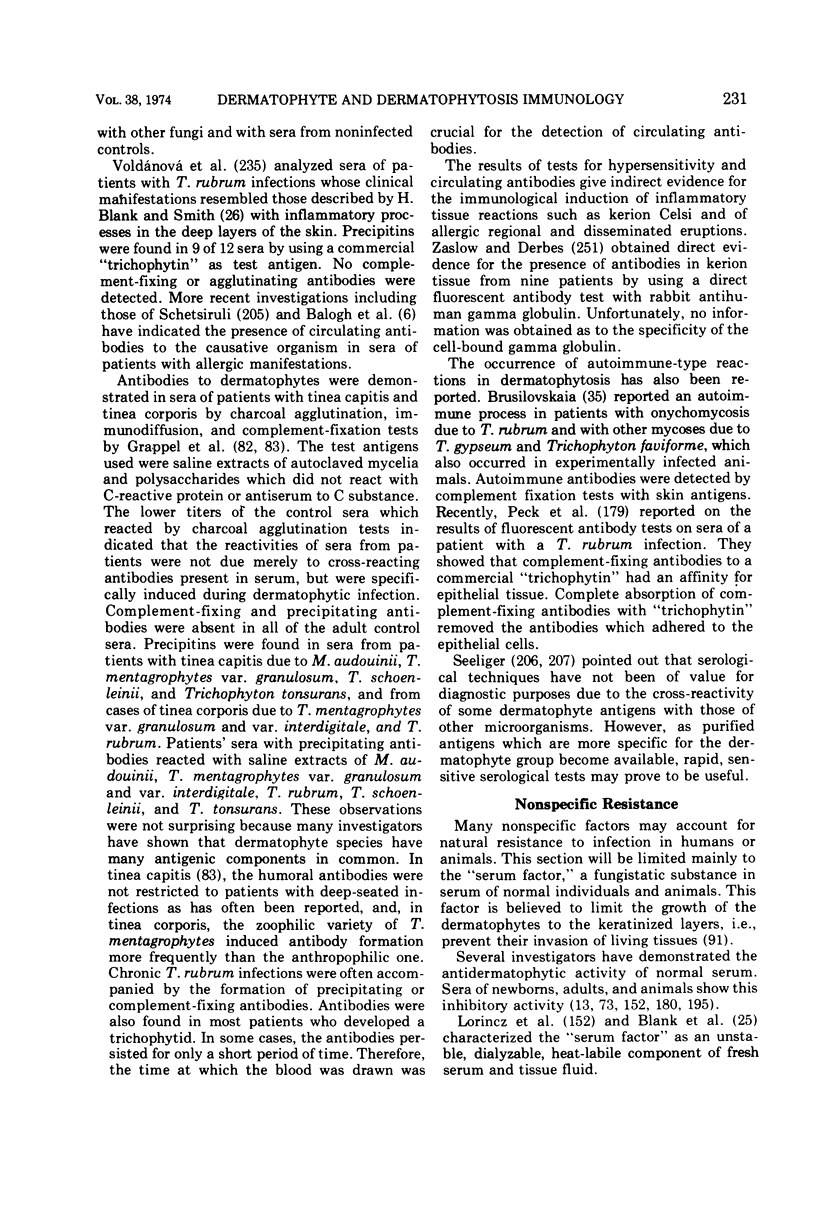
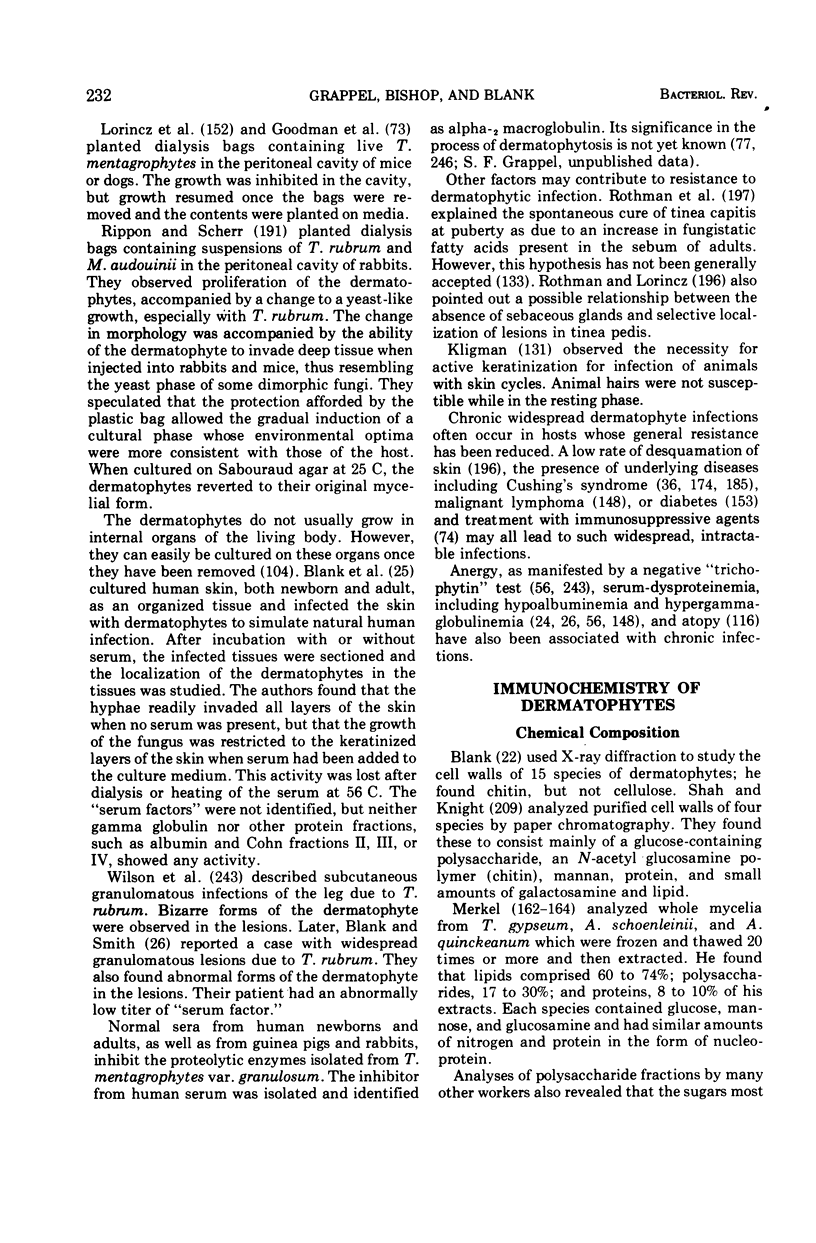
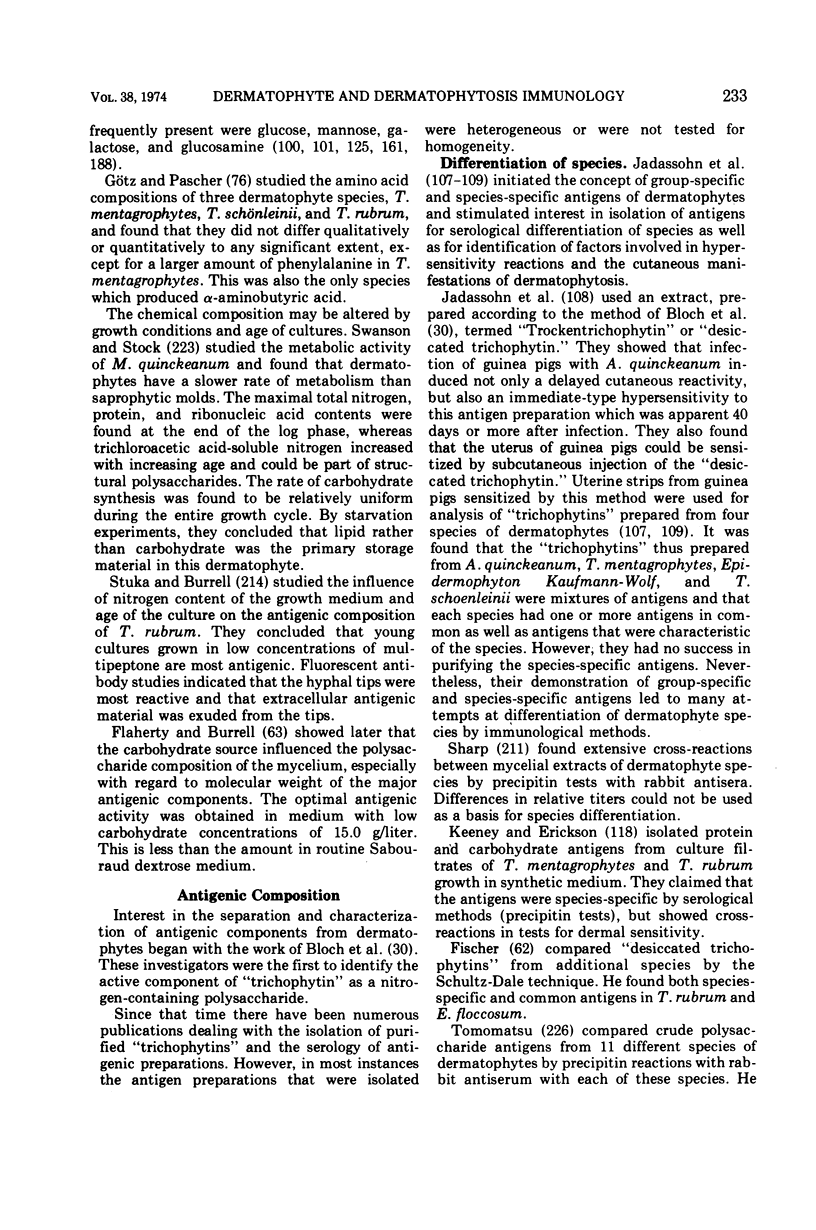
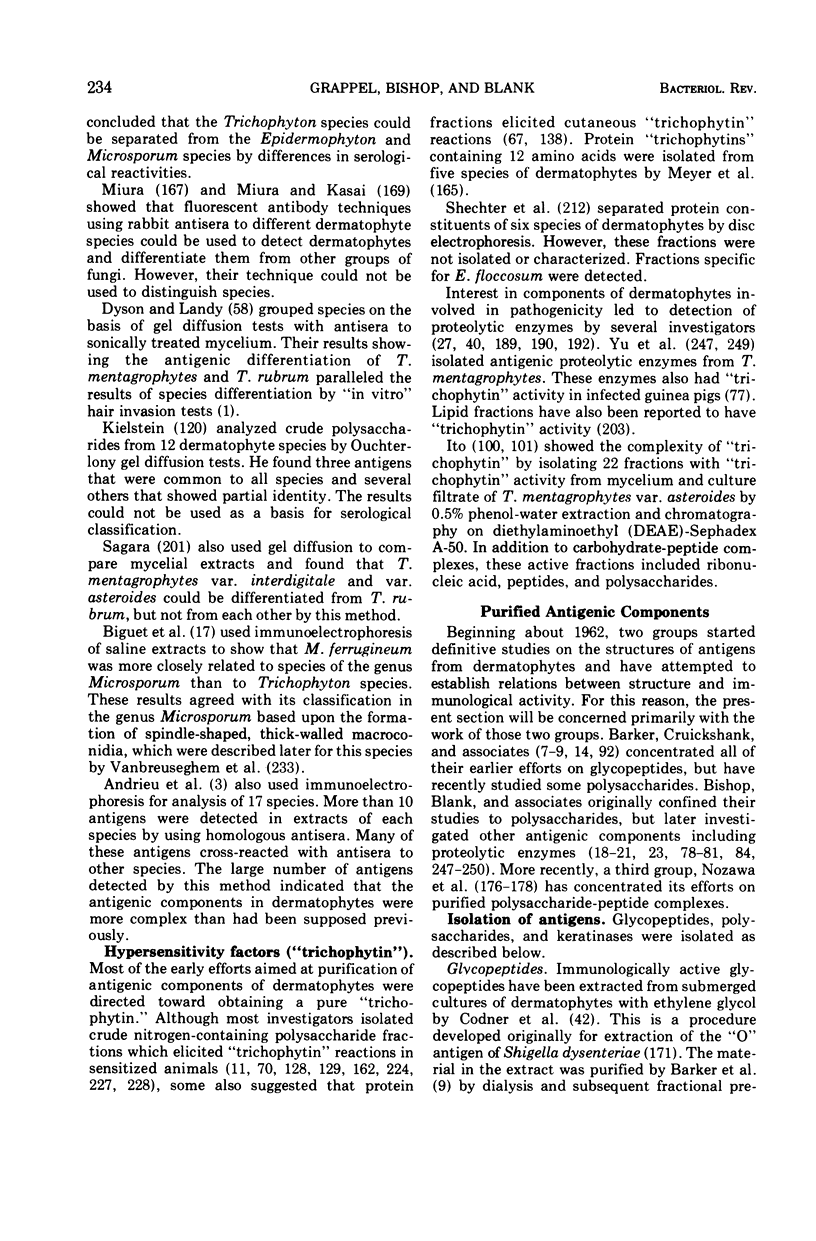
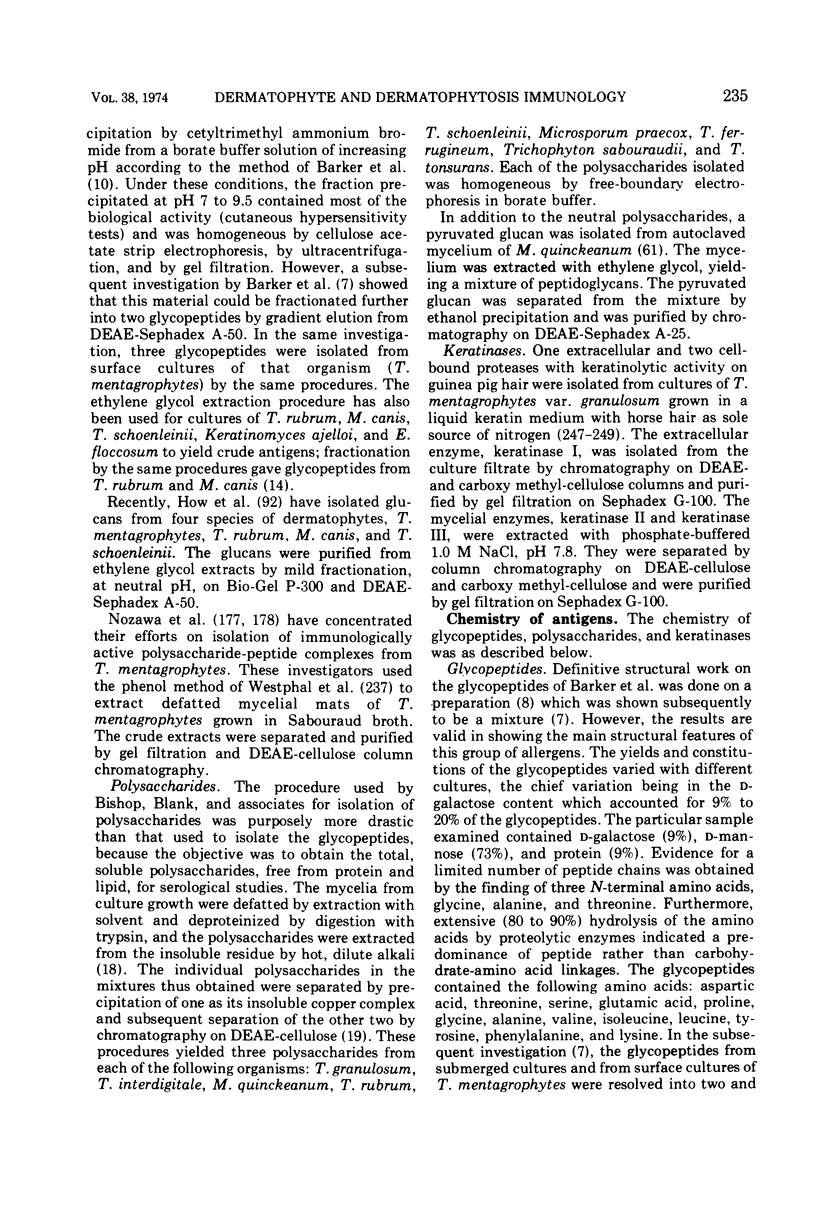
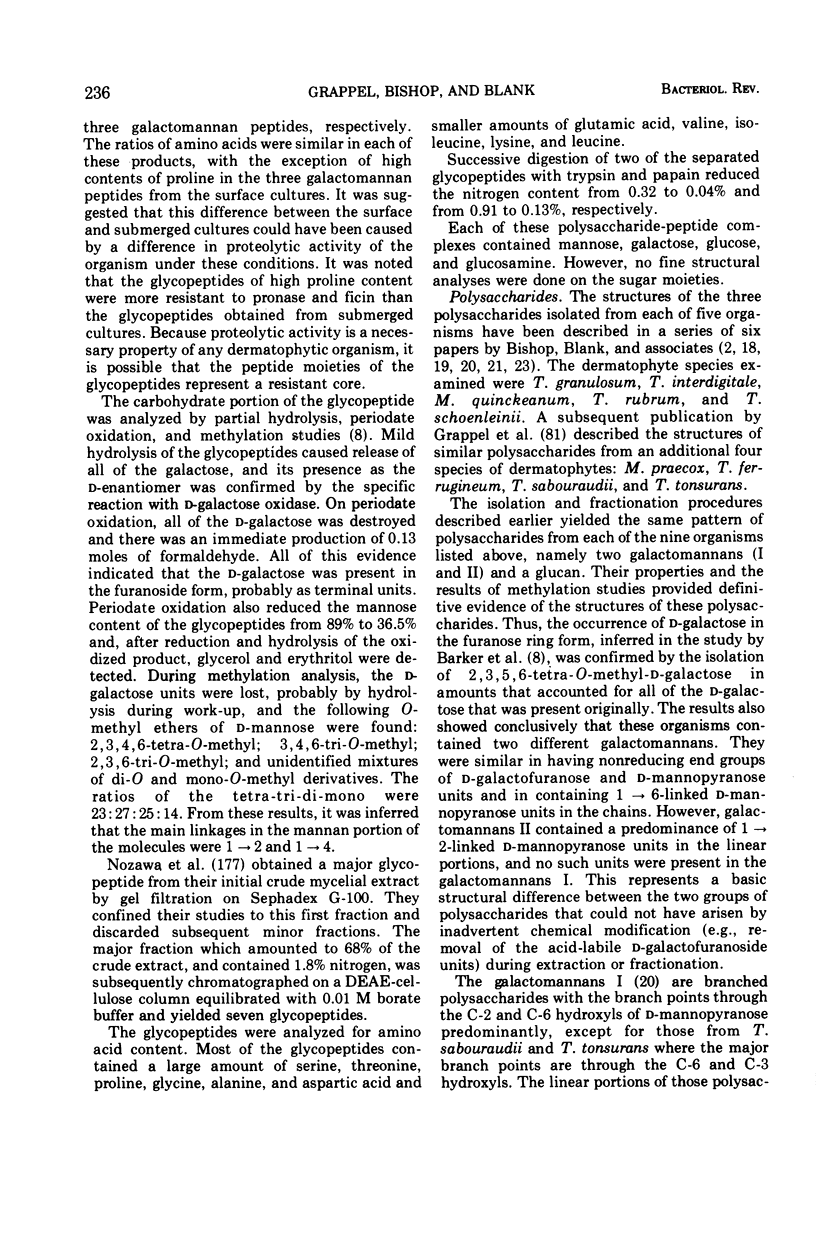
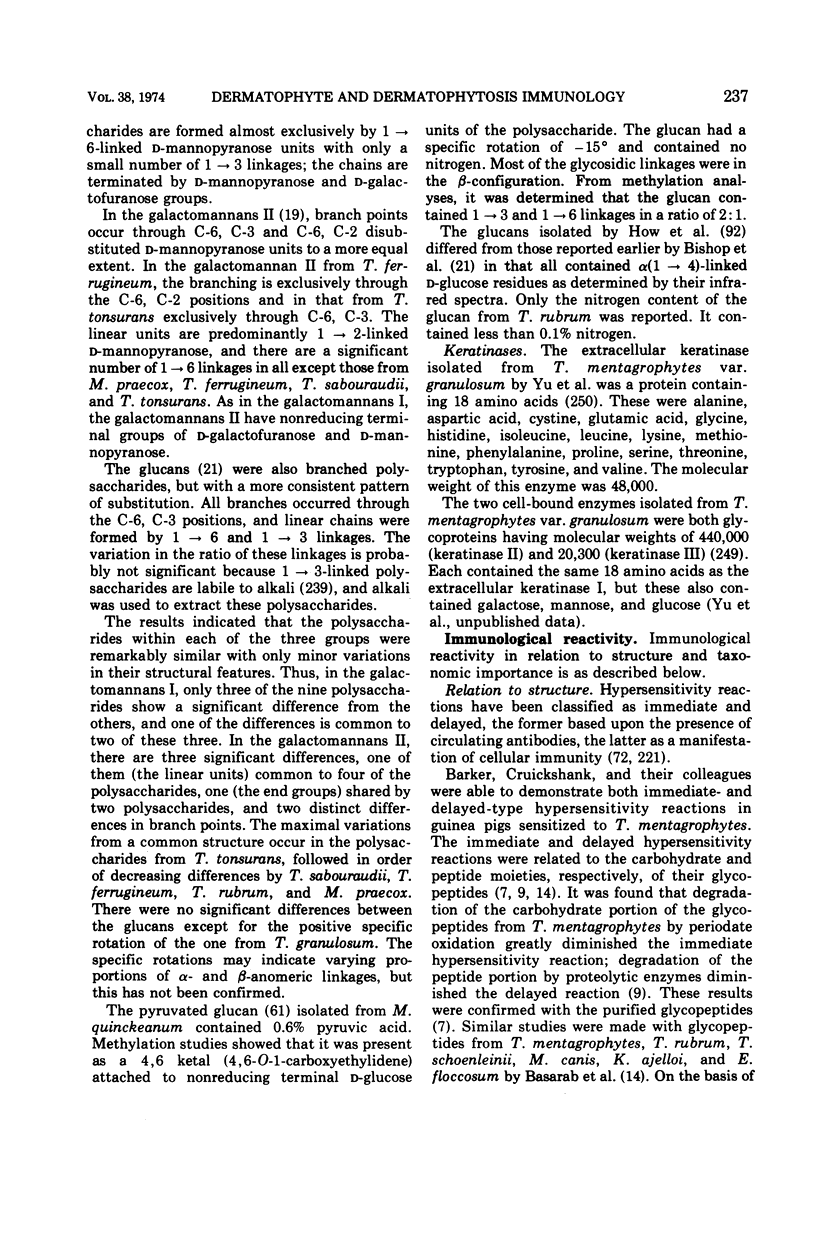
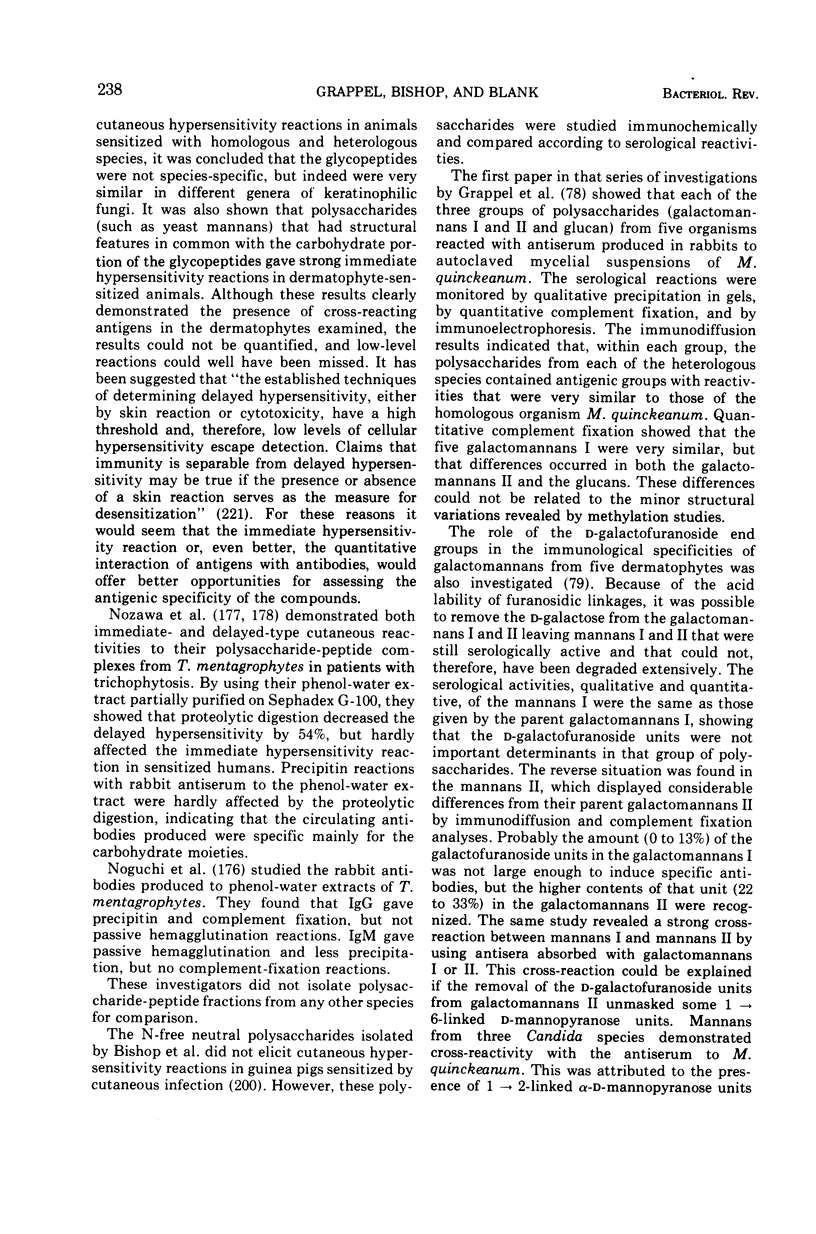
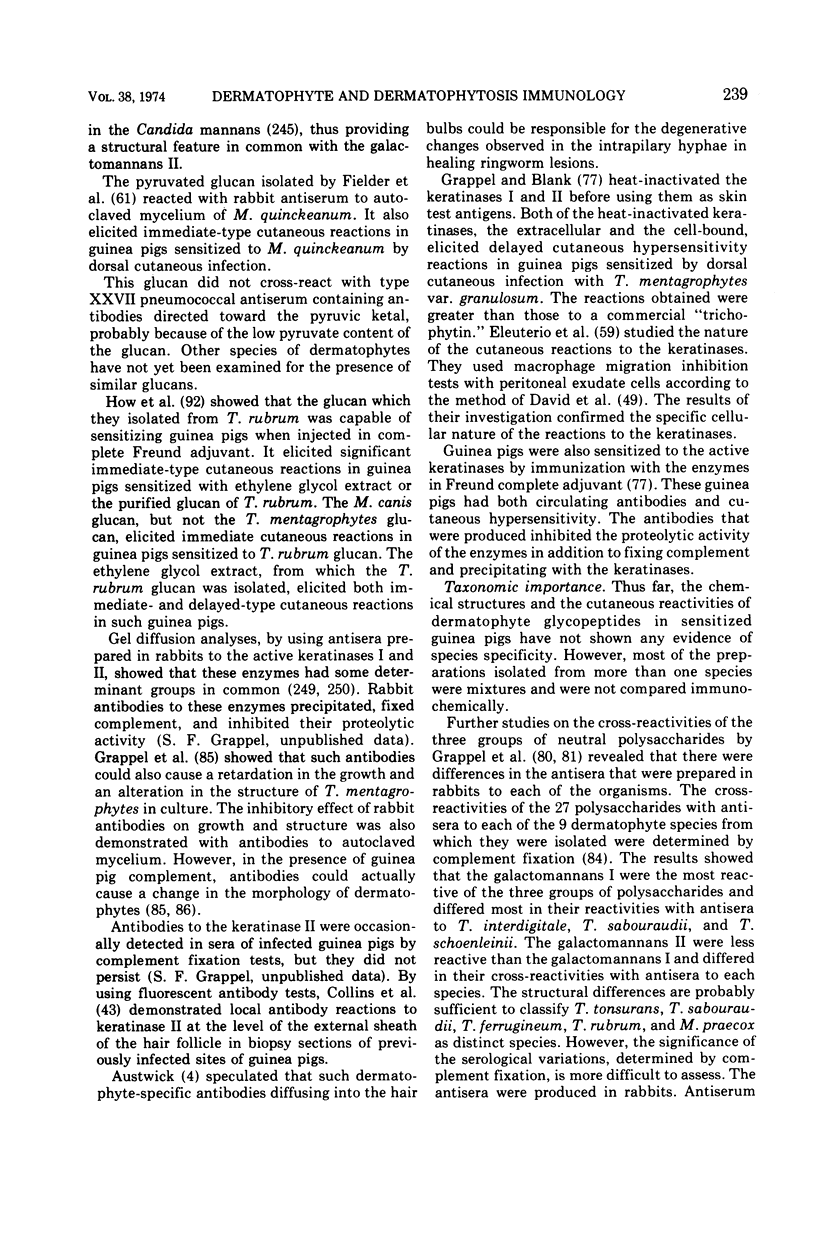
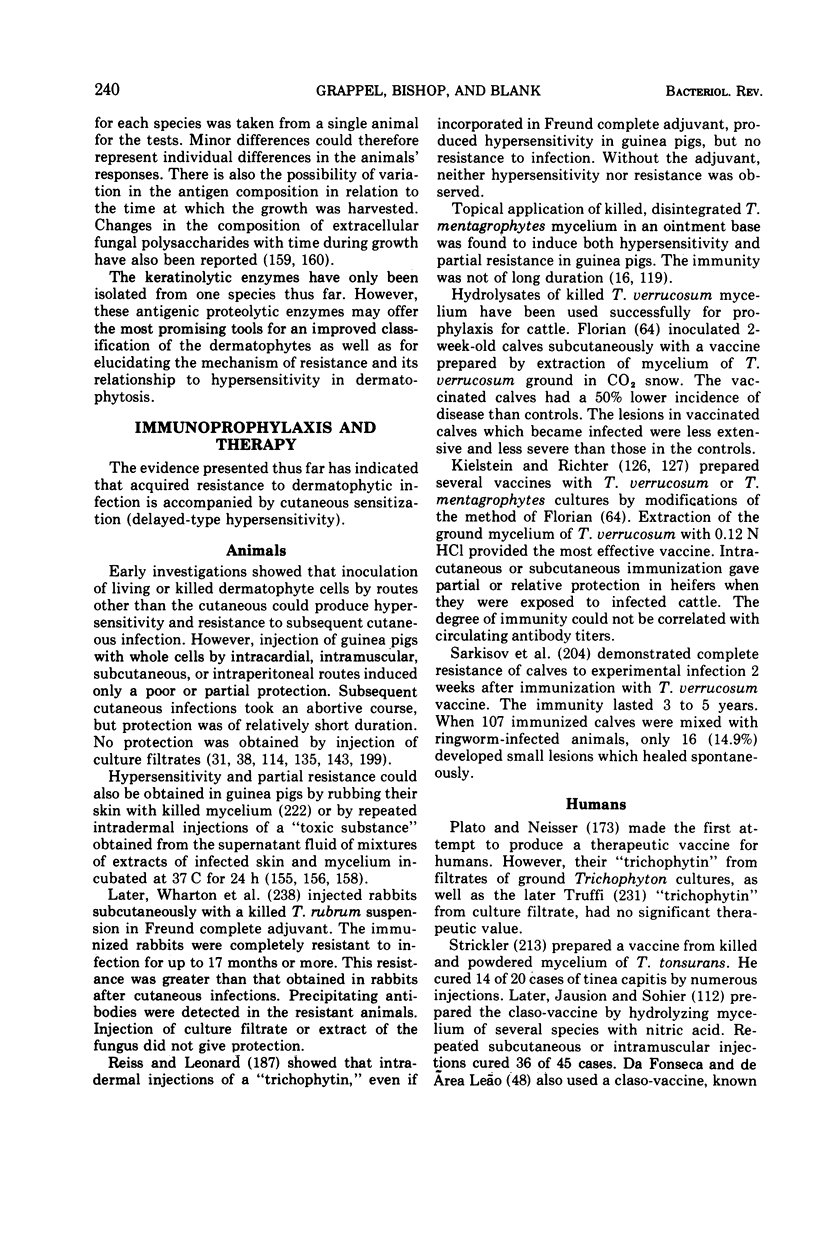
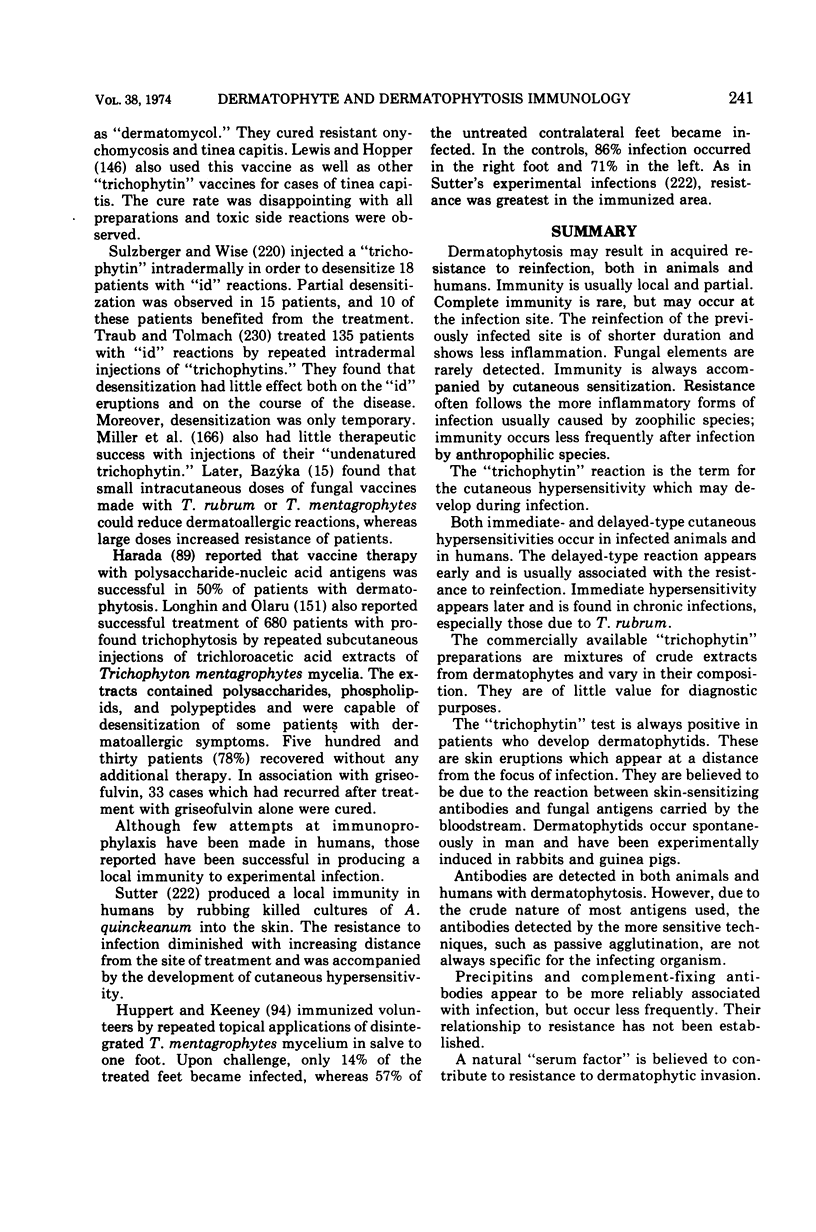
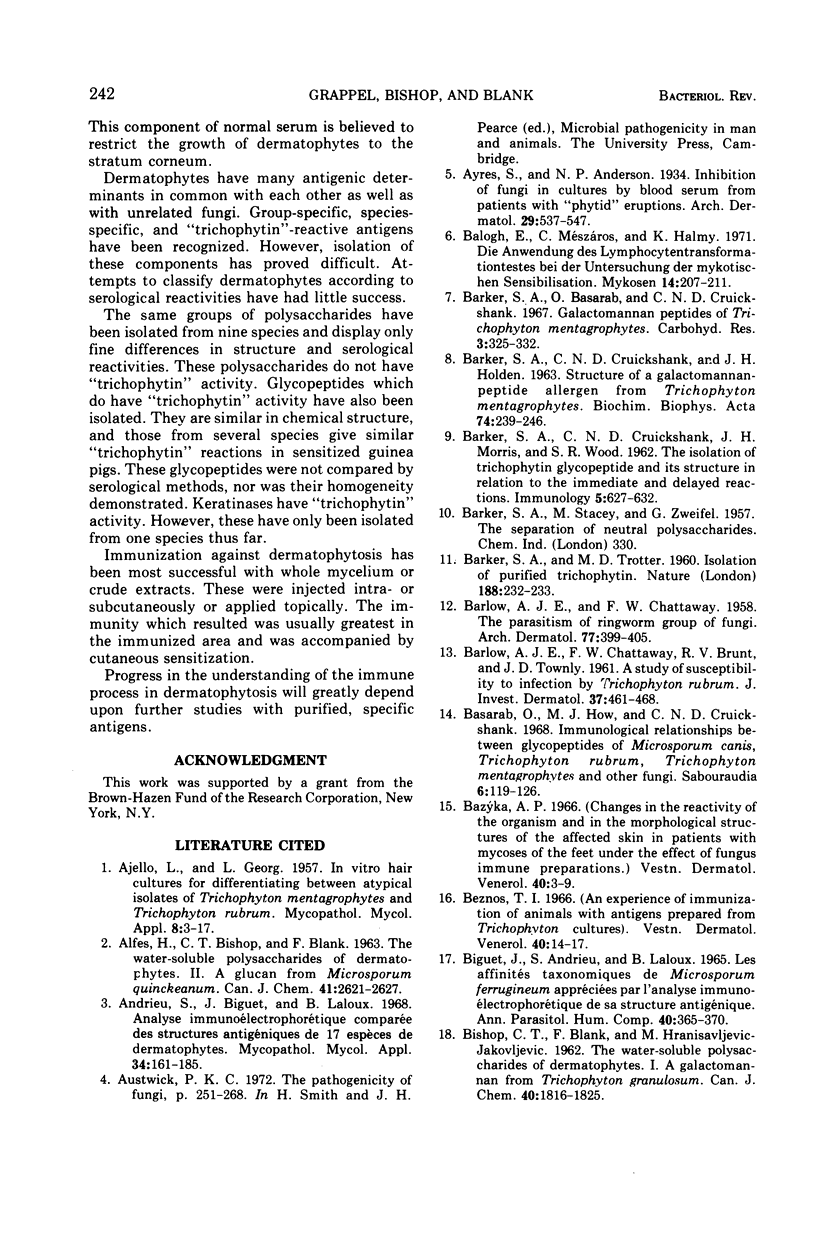
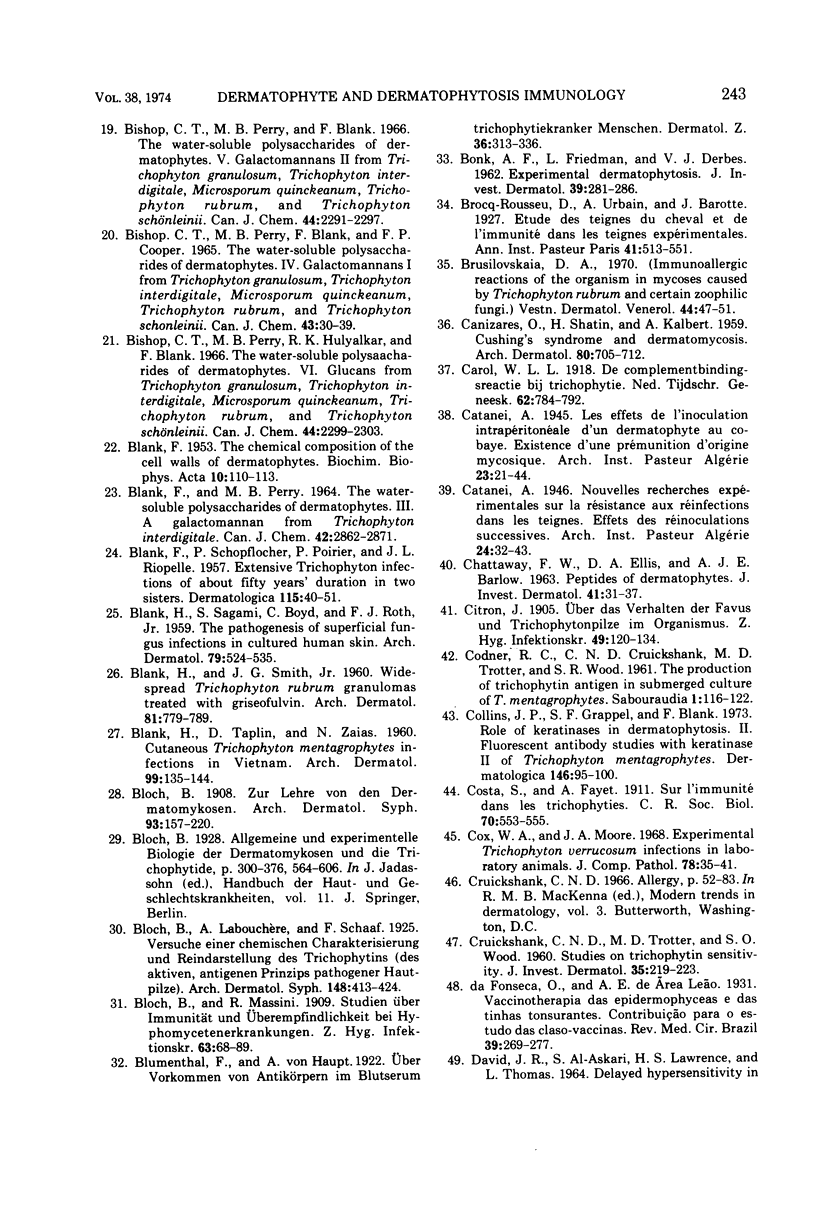
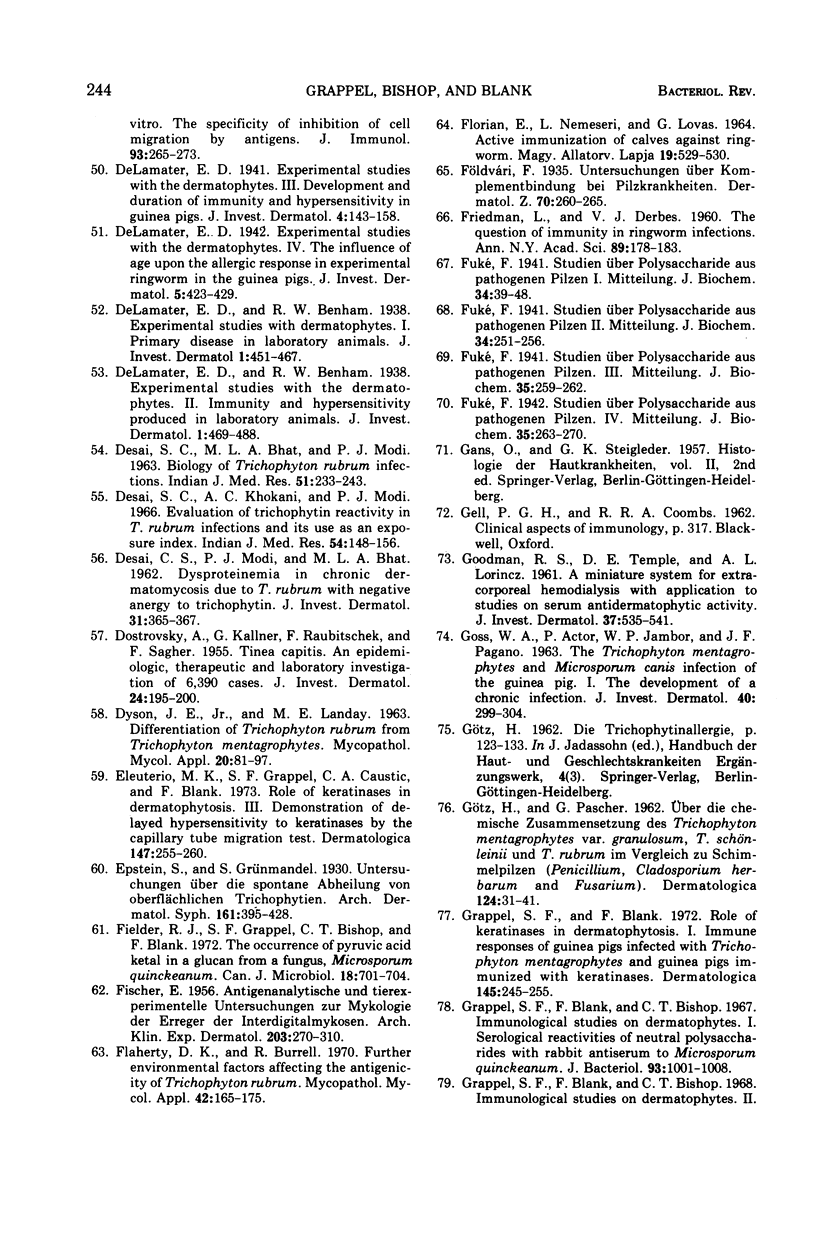
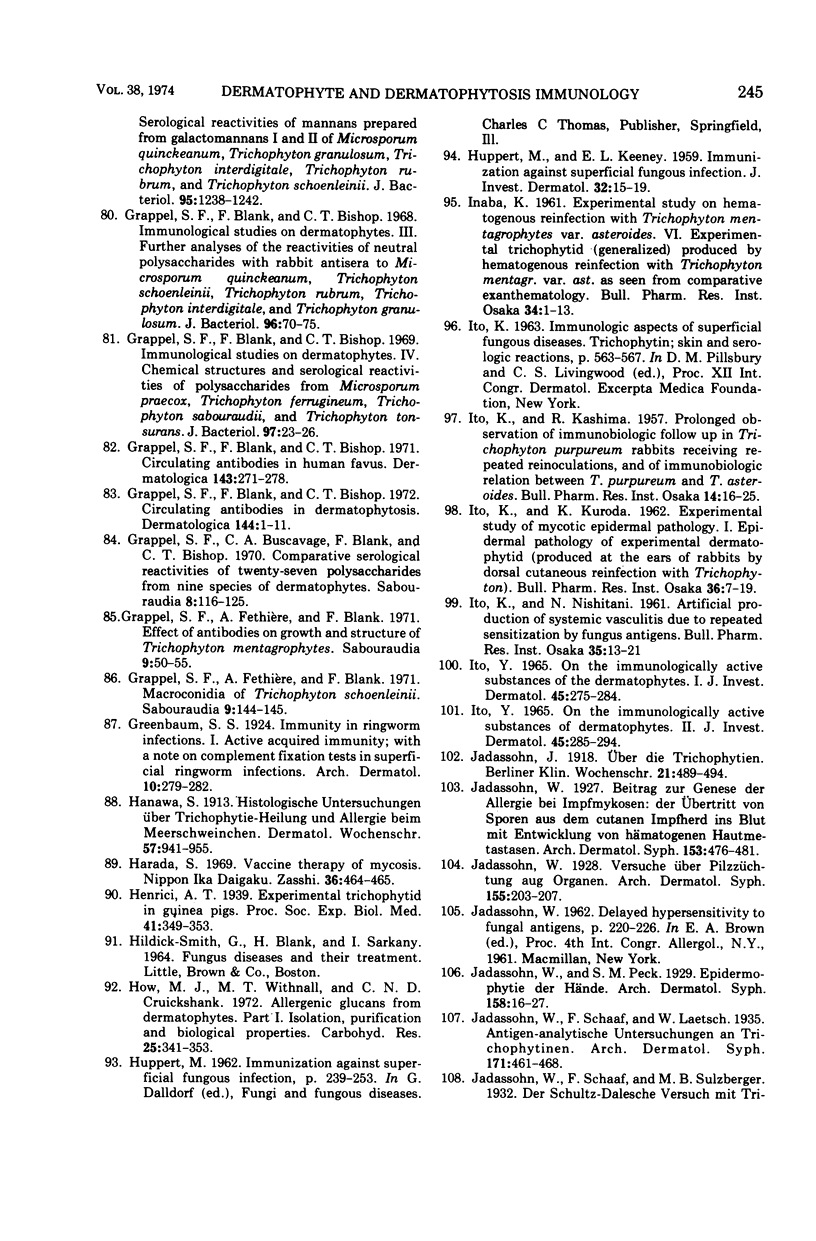
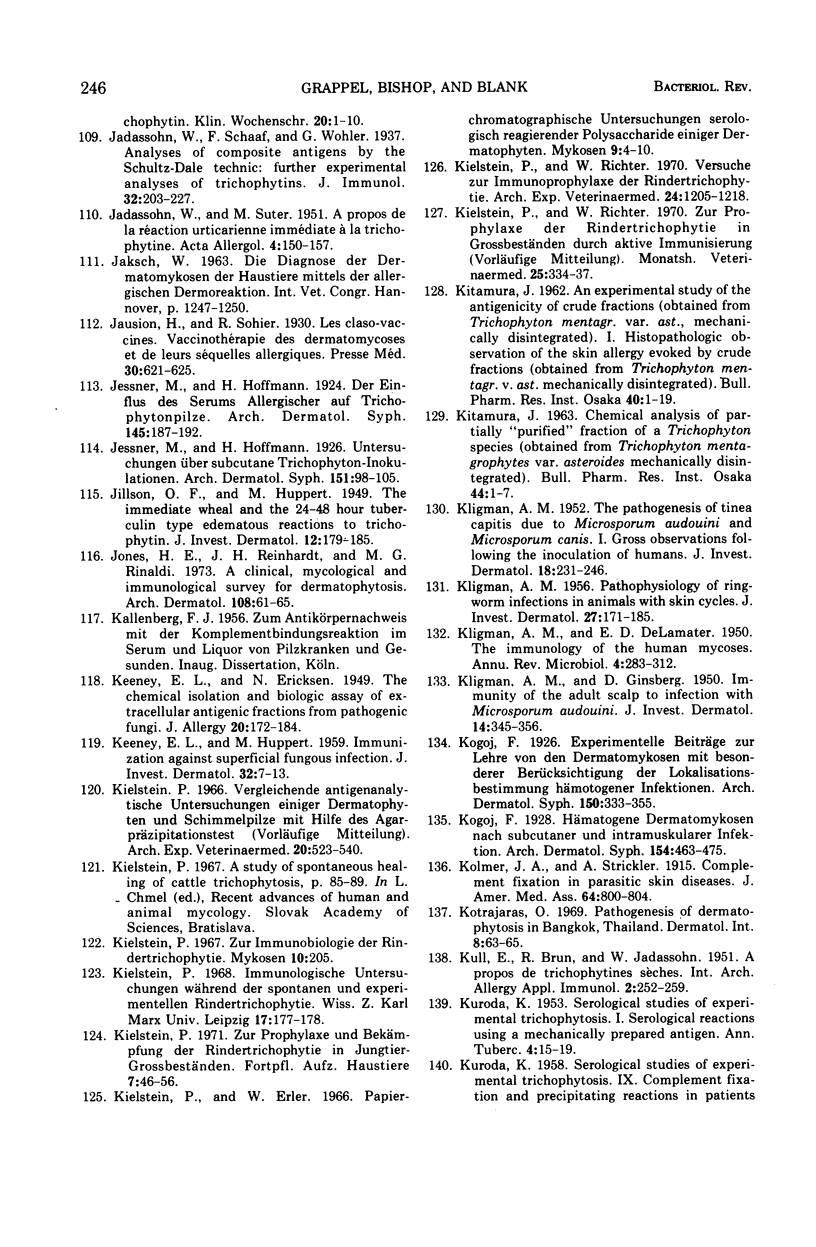
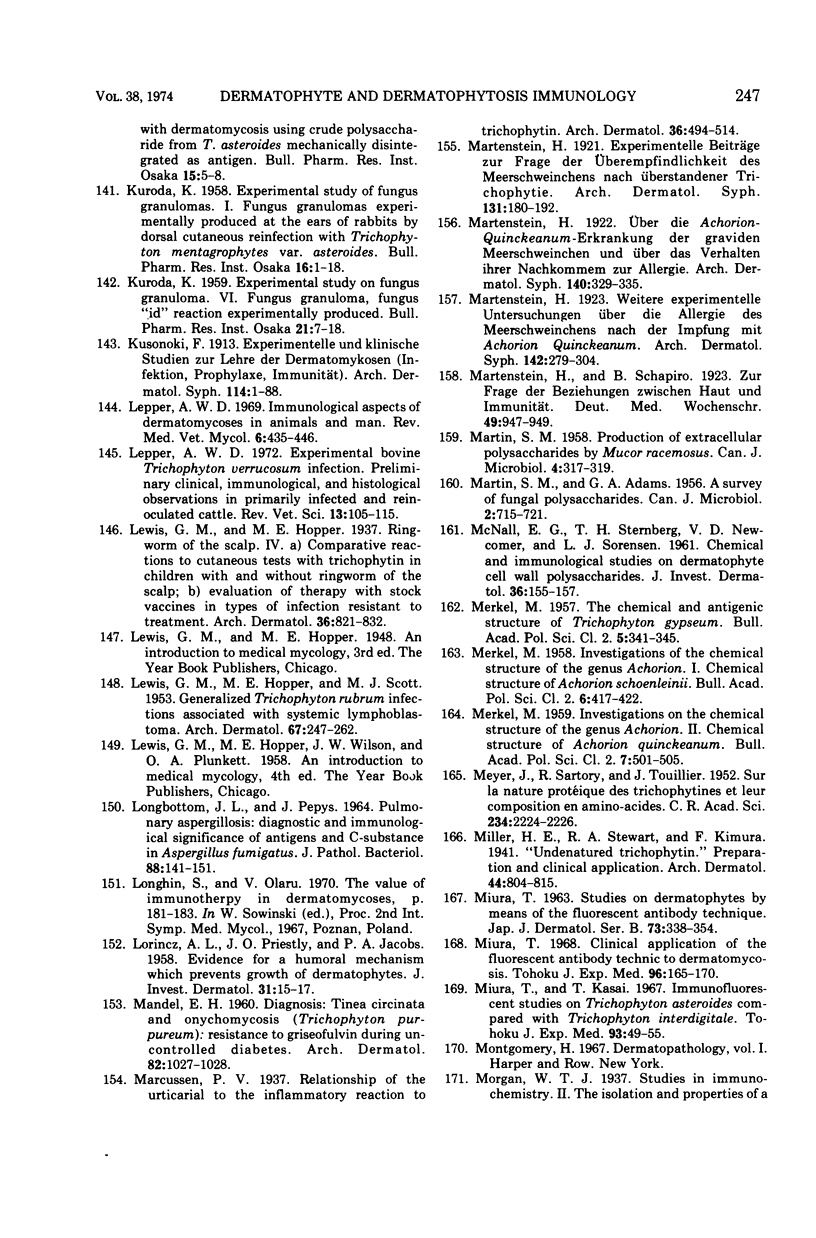
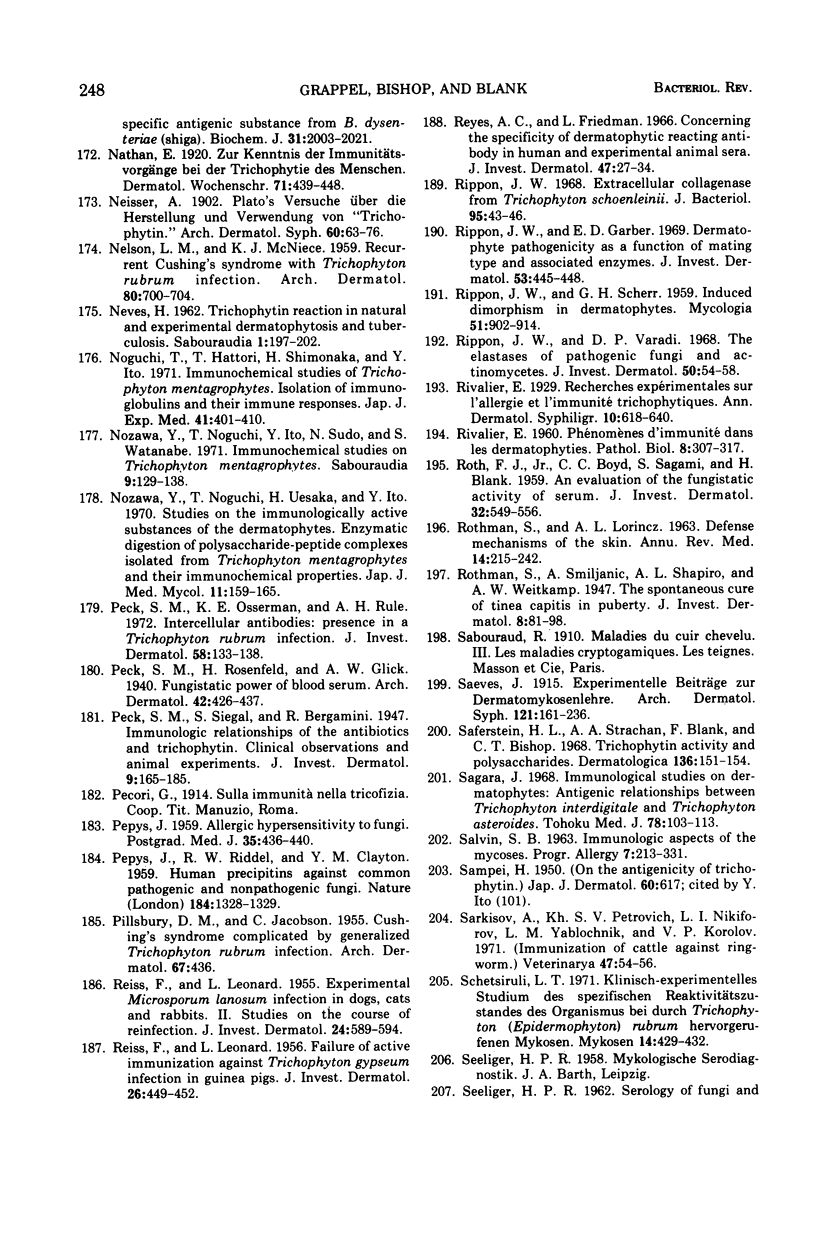
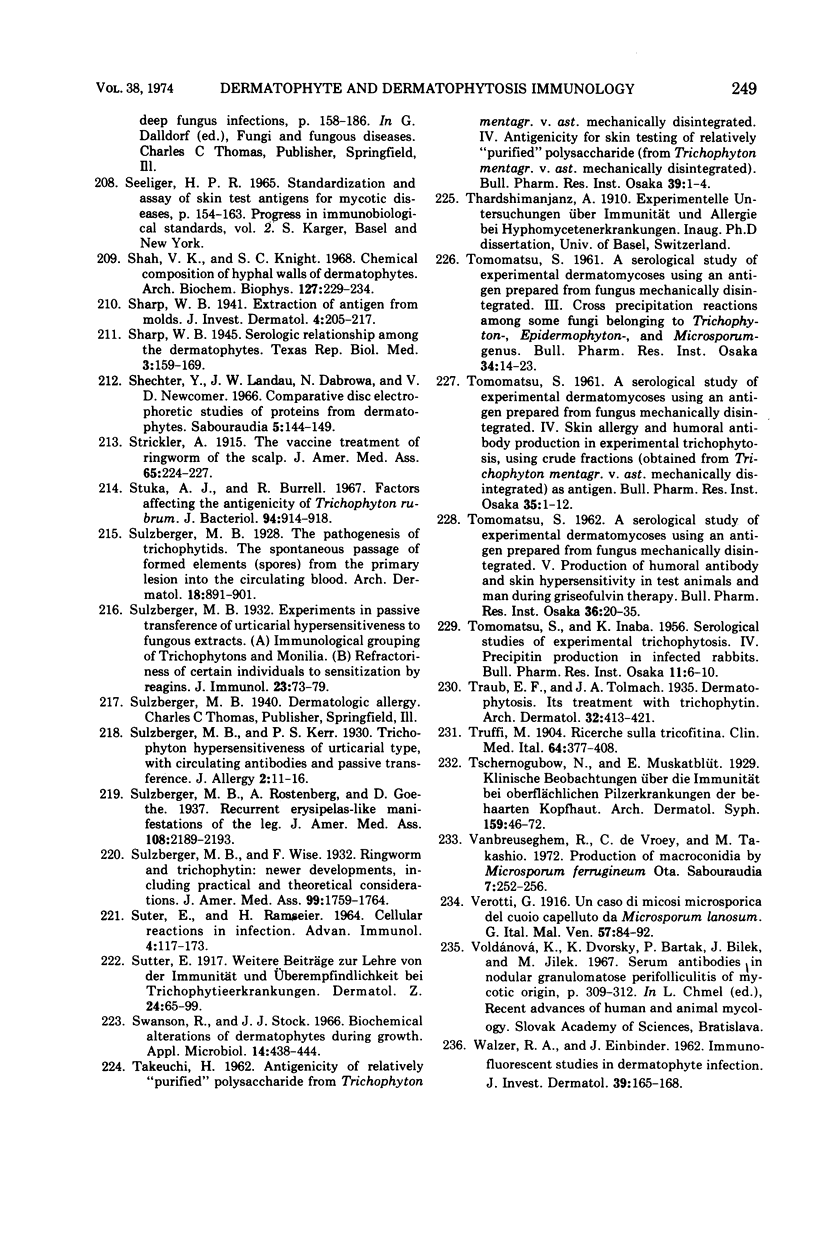
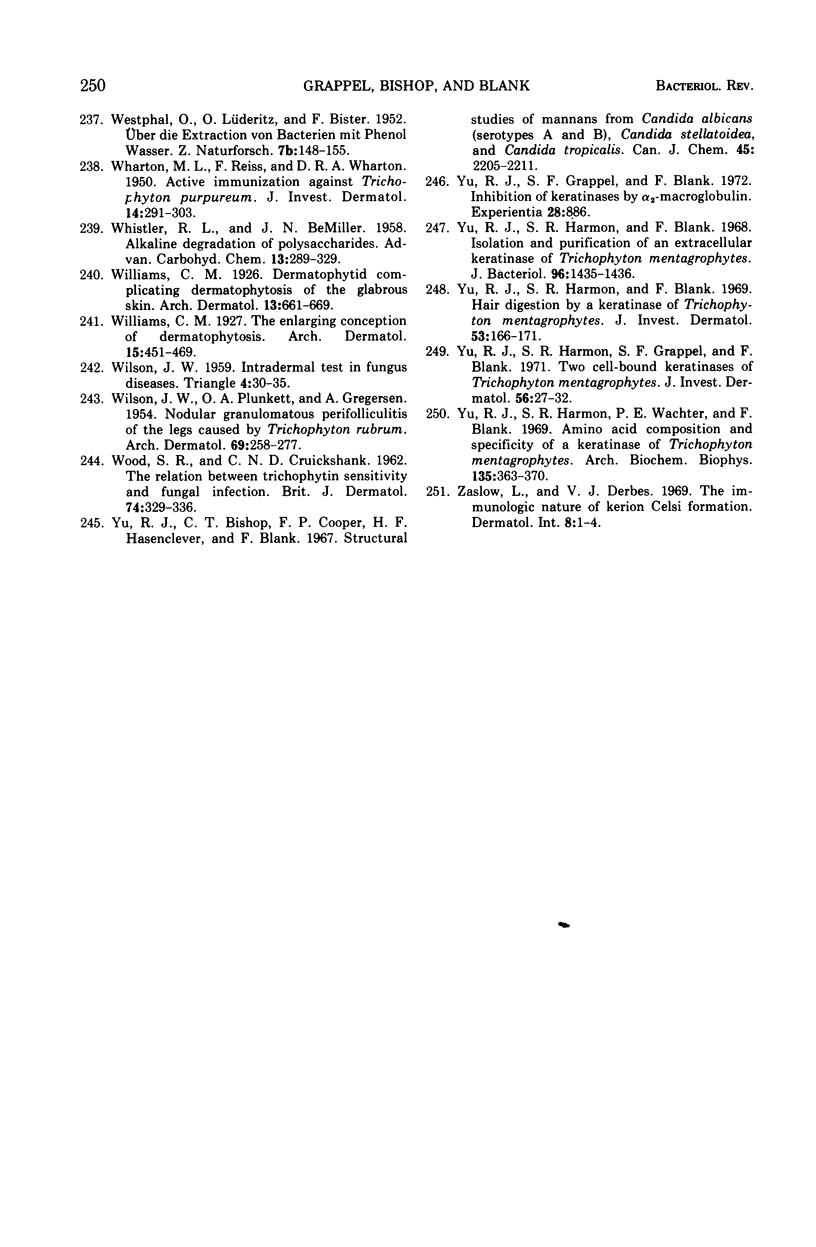
Selected References
These references are in PubMed. This may not be the complete list of references from this article.
- AJELLO L., GEORG L. K. In vitro hair cultures for differentiating between atypical isolates of Trichophyton mentagrophytes and Trichophyton rubrum. Mycopathol Mycol Appl. 1957 Mar 25;8(1):3–17. doi: 10.1007/BF02053114. [DOI] [PubMed] [Google Scholar]
- Andrieu S., Biguet J., Laloux B. Analyse immunoélectrophorétique comparée des structures antigéniques de 17 espèces de dermatophytes. Mycopathol Mycol Appl. 1968 Mar 22;34(2):161–185. doi: 10.1007/BF02051425. [DOI] [PubMed] [Google Scholar]
- BARKER S. A., CRUICKSHANK C. N., HOLDEN J. H. Structure of a galactomannan--peptide allergen from Trichophyton mentagrophytes. Biochim Biophys Acta. 1963 Jul 16;74:239–246. doi: 10.1016/0006-3002(63)91362-3. [DOI] [PubMed] [Google Scholar]
- BARKER S. A., CRUICKSHANK C. N., MORRIS J. H., WOOD S. R. The isolation of trichophytin glycopeptide and its structure in relation to the immediate and delayed reactions. Immunology. 1962 Nov;5:627–632. [PMC free article] [PubMed] [Google Scholar]
- BARLOW A. J., CHATTAWAY F. W., BRUNT R. V., TOWNSLEY J. D. A study of susceptibility to infection by Trichophyton rubrum. J Invest Dermatol. 1961 Dec;37:461–468. doi: 10.1038/jid.1961.145. [DOI] [PubMed] [Google Scholar]
- BARLOW A. J., CHATTAWAY F. W. The parasitism of the ringworm group of fungi. AMA Arch Derm. 1958 Apr;77(4):399–405. doi: 10.1001/archderm.1958.01560040023004. [DOI] [PubMed] [Google Scholar]
- BLANK F., SCHOPFLOCHER P., POIRIER P., RIOPELLE J. L. Extensive Trichophyton infections of about fifty years' duration in two sisters. Dermatologica. 1957 Jul;115(1):40–51. doi: 10.1159/000255985. [DOI] [PubMed] [Google Scholar]
- BLANK F. The chemical composition of the cell walls of dermatophytes. Biochim Biophys Acta. 1953 Jan;10(1):110–113. doi: 10.1016/0006-3002(53)90217-0. [DOI] [PubMed] [Google Scholar]
- BLANK H., SAGAMI S., BOYD C., ROTH F. J., Jr The pathogenesis of superficial fungous infections in cultured human skin. AMA Arch Derm. 1959 May;79(5):524–535. doi: 10.1001/archderm.1959.01560170022005. [DOI] [PubMed] [Google Scholar]
- BLANK H., SMITH J. G., Jr Widespread Trichophyton rubrum granulomas treated with griseofulvin. Arch Dermatol. 1960 May;81:779–789. doi: 10.1001/archderm.1960.03730050135025. [DOI] [PubMed] [Google Scholar]
- BONK A. F., FRIEDMAN L., DERBES V. J. Experimental dermatophytosis. J Invest Dermatol. 1962 Oct;39:281–286. doi: 10.1038/jid.1962.113. [DOI] [PubMed] [Google Scholar]
- Balogh E., Mészáros C., Halmy K. Die Anwendung des Lymphocytentransformationstestes bei der Untersuchung der mykotischen Sensibilisation. Mykosen. 1971 May 1;14(5):207–211. [PubMed] [Google Scholar]
- Basarab O., How M. J., Cruickshank C. N. Immunological relationships between glycopeptides of Microsporum canis, Trichophyton rubrum, Trichophyton mentagrophytes and other fungi. Sabouraudia. 1968 Feb;6(2):119–126. [PubMed] [Google Scholar]
- Biguet J., Andrieu S., Laloux B. Les affinités taxonomiques de Microsporum ferrugineum Ota, 1922 appréciées par l'analyse immunoélectrophorétique de sa structure antigénique. Ann Parasitol Hum Comp. 1965 May-Jun;40(3):365–370. [PubMed] [Google Scholar]
- Blank H., Taplin D., Zaias N. Cutaneous Trichophyton mentagrophytes infections in Vietnam. Arch Dermatol. 1969 Feb;99(2):135–144. [PubMed] [Google Scholar]
- CANIZARES O., SHATIN H., KELLERT A. J. Cushing's syndrome and dermatomycosis. Arch Dermatol. 1959 Dec;80:705–712. doi: 10.1001/archderm.1959.01560240057007. [DOI] [PubMed] [Google Scholar]
- CHATTAWAY F. W., ELLIS D. A., BARLOW A. J. PEPTIDASES OF DERMATOPHYTES. J Invest Dermatol. 1963 Jul;41:31–37. [PubMed] [Google Scholar]
- CODNER R. C., CRUICKSHANK C. N., TROTTER M. D., WOOD S. R. The production of trichophytin antigen in submerged culture of Trichophyton mentagrophytes. Sabouraudia. 1961 Jun;1:116–122. doi: 10.1080/00362176285190241. [DOI] [PubMed] [Google Scholar]
- CRUICKSHANK C. N., TROTTER M. D., WOOD S. R. Studies on tricophytin sensitivity. J Invest Dermatol. 1960 Oct;35:219–223. [PubMed] [Google Scholar]
- Collins J. P., Grappel S. F., Blank F. Role of keratinases in dermatophytosis. II. Fluorescent antibody studies with keratinase II of Trichophyton mentagrophytes. Dermatologica. 1973;146(2):95–100. [PubMed] [Google Scholar]
- Cox W. A., Moore J. A. Experimental Trichophyton verrucosum infections in laboratory animals. J Comp Pathol. 1968 Jan;78(1):35–41. doi: 10.1016/0021-9975(68)90110-2. [DOI] [PubMed] [Google Scholar]
- DAVID J. R., AL-ASKARI S., LAWRENCE H. S., THOMAS L. DELAYED HYPERSENSITIVITY IN VITRO. I. THE SPECIFICITY OF INHIBITION OF CELL MIGRATION BY ANTIGENS. J Immunol. 1964 Aug;93:264–273. [PubMed] [Google Scholar]
- DESAI S. C., BHAT M. L., MODI P. J. Biology of T. rubrum infections. Indian J Med Res. 1963 Mar;51:233–243. [PubMed] [Google Scholar]
- DESAI S. C., MODI P. J., BHAT M. A. Dysproteinemia in the chronic dermatomycosis due to T. rubrum with negative anergy to trichophytin. J Invest Dermatol. 1962 Nov;39:365–367. doi: 10.1038/jid.1962.125. [DOI] [PubMed] [Google Scholar]
- DOSTROVSKY A., KALLNER G., RAUBITSCHEK F., SAGHER F. Tinea capitis: an epidemiologic, therapeutic and laboratory investigation of 6,390 cases. J Invest Dermatol. 1955 Mar;24(3):195–200. [PubMed] [Google Scholar]
- DYSON J. E., Jr, LANDAY M. E. DIFFERENTIATION OF TRICHOPHYTON RUBRUM FROM TRICHOPHYTON MENTAGROPHYTES. Mycopathol Mycol Appl. 1963 Aug 31;20:81–97. doi: 10.1007/BF02054880. [DOI] [PubMed] [Google Scholar]
- Desai S. C., Khokhani R. C., Modi P. J. Evaluation of trichophytin reactivity in T. rubrum infections and its use as a survey method of exposure index. Indian J Med Res. 1966 Feb;54(2):148–156. [PubMed] [Google Scholar]
- Eleuterio M. K., Grappel S. F., Caustic C. A., Blank F. Role of keratinases in dermatophytosis. 3. Demonstration of delayed hypersensitivity to keratinases by the capillary tube migration test. Dermatologica. 1973;147(4):255–260. [PubMed] [Google Scholar]
- FISCHER E. Antigenanalytische und tierexperimentelle Untersuchungen zur Mykologie der Erreger der Interdigitalmykosen. Arch Klin Exp Dermatol. 1956;203(3):270–310. [PubMed] [Google Scholar]
- FRIEDMAN L., DERBES V. J. The question of immunity in ringworm infections. Ann N Y Acad Sci. 1960 Aug 27;89:178–183. doi: 10.1111/j.1749-6632.1960.tb20140.x. [DOI] [PubMed] [Google Scholar]
- Fielder R. J., Grappel S. F., Bishop C. T., Blank F. The occurrence of pyruvic acid ketal in a glucan from a fungus, Microsporum quinckeanum. Can J Microbiol. 1972 May;18(5):701–704. doi: 10.1139/m72-112. [DOI] [PubMed] [Google Scholar]
- Flaherty D. K., Burrell R. Further environmental factors affecting the antigenicity of Trichophyton rubrum. Mycopathol Mycol Appl. 1970 Dec 28;42(1):165–175. doi: 10.1007/BF02051838. [DOI] [PubMed] [Google Scholar]
- GOETZ H., PASCHER G. [On the chemical composition of Trichophyton mentagrophytes var. granulosum, T. schoenleinii and T. rubrum in comparison to molds (Pennicillium, Cladosporium herbarum and Fusarium)]. Dermatologica. 1962;124:31–41. [PubMed] [Google Scholar]
- GOODMAN R. S., TEMPLE D. E., LORINCZ A. L. A miniature system for extracorporeal hemodialysis with application to studies on serum anti-dermatophytic activity. J Invest Dermatol. 1961 Dec;37:535–541. [PubMed] [Google Scholar]
- GOSS W. A., ACTOR P., JAMBOR W. P., PAGANO J. F. The Trichophyton mentagrophytes and Microsporum canis infection of the guinea-pig. J Invest Dermatol. 1963 Jun;40:299–304. doi: 10.1038/jid.1963.153. [DOI] [PubMed] [Google Scholar]
- Grappel S. F., Blank F., Bishop C. T. Circulating antibodies in dermatophytosis. Dermatologica. 1972;144(1):1–11. doi: 10.1159/000252089. [DOI] [PubMed] [Google Scholar]
- Grappel S. F., Blank F., Bishop C. T. Circulating antibodies in human favus. Dermatologica. 1971;143(5):271–276. doi: 10.1159/000252217. [DOI] [PubMed] [Google Scholar]
- Grappel S. F., Blank F., Bishop C. T. Immunological studies on dermatophytes. 3. Further analyses of the reactivities of neutral polysaccharides with rabbit antisera to Microsporum quinckeanum, Trichophyton schoenleinii, Trichophyton rubrum, Trichophyton interdigitale, and Trichophyton granulosum. J Bacteriol. 1968 Jul;96(1):70–75. doi: 10.1128/jb.96.1.70-75.1968. [DOI] [PMC free article] [PubMed] [Google Scholar]
- Grappel S. F., Blank F., Bishop C. T. Immunological studies on dermatophytes. I. Serological reactivities of neutral polysaccharides with rabbit antiserum to Microsporum quinckeanum. J Bacteriol. 1967 Mar;93(3):1001–1008. doi: 10.1128/jb.93.3.1001-1008.1967. [DOI] [PMC free article] [PubMed] [Google Scholar]
- Grappel S. F., Blank F., Bishop C. T. Immunological studies on dermatophytes. IV. Chemical structures and serological reactivities of polysaccharides from Microsporum praecox, Trichophyton ferrugineum, Trichophyton sabouraudii, and Trichophyton tonsurans. J Bacteriol. 1969 Jan;97(1):23–26. doi: 10.1128/jb.97.1.23-26.1969. [DOI] [PMC free article] [PubMed] [Google Scholar]
- Grappel S. F., Blank F. Role of keratinases in dermatophytosis. I. Immune responses of guinea pigs infected with Trichophyton mentagrophytes and guinea pigs immunized with keratinases. Dermatologica. 1972;145(4):245–255. [PubMed] [Google Scholar]
- Grappel S. F., Buscavage C. A., Blank F., Bishop C. T. Comparative serological reactivities of twenty-seven polysaccharides from nine species of dermatophytes. Sabouraudia. 1970 Aug;8(2):116–125. doi: 10.1080/00362177085190741. [DOI] [PubMed] [Google Scholar]
- Grappel S. F., Fethiere A., Blank F. Effect of antibodies on growth and structure of Trichophyton mentagrophytes. Sabouraudia. 1971 Mar;9(1):50–55. doi: 10.1080/00362177185190131. [DOI] [PubMed] [Google Scholar]
- Grappel S. F., Fethière A., Blank F. Macroconidia of Trichophyton schoenleinii. Sabouraudia. 1971 Jul;9(2):144–145. [PubMed] [Google Scholar]
- HUPPERT M., KEENEY E. L. Immunization against superficial fungous infection. II. Studies on human volunteer subjects. J Invest Dermatol. 1959 Jan;32(1):15–19. doi: 10.1038/jid.1959.5. [DOI] [PubMed] [Google Scholar]
- Harada S. [Vaccine therapy of mycosis]. Nihon Ika Daigaku Zasshi. 1969;36(6):464–465. [PubMed] [Google Scholar]
- How M. J., Withnall M. T., Cruickshank C. N. Allergenic glucans from dermatophytes. I. Isolation, purification, and biological properties. Carbohydr Res. 1972 Dec;25(2):341–353. doi: 10.1016/s0008-6215(00)81644-4. [DOI] [PubMed] [Google Scholar]
- INABA K. Experimental study of hematogenous reinfection with Trichophyton mentagr., v. ast. VI. Experimental trichophytid (generalized) produced by hematogenous reinfection with Trichophyton mentagr., v. ast., as seen from comparative exanthematology. Bull Pharm Res Inst. 1961 Sep;34:1–13. [PubMed] [Google Scholar]
- ITO K., NISHITANI N. Artificial production of systemic vasculitis due to repeated sensitization by fungus antigens. Bull Pharm Res Inst. 1961 Nov;35:13–21. [PubMed] [Google Scholar]
- Ito Y. On the immunologically-active substances of the dermatophytes. I. J Invest Dermatol. 1965 Oct;45(4):275–284. doi: 10.1038/jid.1965.129. [DOI] [PubMed] [Google Scholar]
- Ito Y. On the immunologically-active substances of the dermatophytes. II. J Invest Dermatol. 1965 Oct;45(4):285–294. doi: 10.1038/jid.1965.130. [DOI] [PubMed] [Google Scholar]
- Jones H. E., Reinhardt J. H., Rinaldi M. G. A clinical, mycological, and immunological survey for dermatophytosis. Arch Dermatol. 1973 Jul;108(1):61–65. [PubMed] [Google Scholar]
- KEENEY E. L., HUPPERT M. Immunization against superficial fungous infection. I. Studies on experimental animals. J Invest Dermatol. 1959 Jan;32(1):7–13. doi: 10.1038/jid.1959.4. [DOI] [PubMed] [Google Scholar]
- KITAMURA J. An experimental study of the antigenicity of crude fractions (obtained from Trichophyton mentagr., v. ast., mechanically disintegrated). I. Histopathologic observation of skin allergy evoked by crude fractions (obtained from Trichophyton mentagr., v. ast. mechanically disintegrated). Bull Pharm Res Inst. 1962 Sep;40:1–19. [PubMed] [Google Scholar]
- KITAMURA J. CHEMICAL ANALYSIS OF PARTIALLY "PURIFIED" FRACTION OF A TRICHOPHYTON SPECIES (OBTAINED FROM TRICHOPHYTON MENTAGROPHYTES, VAR. ASTEROIDES MECHANICALLY DISINTEGRATED). Bull Pharm Res Inst. 1963 May;44:1–7. [PubMed] [Google Scholar]
- KLIGMAN A. M., DeLAMATER E. D. The immunology of the human mycoses. Annu Rev Microbiol. 1950;4:283–312. doi: 10.1146/annurev.mi.04.100150.001435. [DOI] [PubMed] [Google Scholar]
- KLIGMAN A. M., GINSBERG D. Immunity of the adult scalp to infection with Microsporum audouinii. J Invest Dermatol. 1950 May;14(5):345–358. doi: 10.1038/jid.1950.43. [DOI] [PubMed] [Google Scholar]
- KLIGMAN A. M. Pathophysiology of ringworm infections in animals with skin cycles. J Invest Dermatol. 1956 Sep;27(3):171–185. doi: 10.1038/jid.1956.90. [DOI] [PubMed] [Google Scholar]
- KLIGMAN A. M. The pathogenesis of Tinea capitis due to Microsporum audouini and Microsporum canis. I. Gross observations following the inoculation of humans. J Invest Dermatol. 1952 Mar;18(3):231–246. doi: 10.1038/jid.1952.27. [DOI] [PubMed] [Google Scholar]
- KULL E., BRUN R., JADASSOHN W. A propos de trichophytines sèches. Int Arch Allergy Appl Immunol. 1951;2(3):252–259. [PubMed] [Google Scholar]
- KURODA T. Serological studies of experimental trichophytosis. I. Serological reaction using a mechanically prepared antigen. Ann Tuberc. 1953 Apr;4(1):15–19. [PubMed] [Google Scholar]
- Kielstein P., Richter W. Versuche zur Immunprophylaxe der Rindertrichophytie. Arch Exp Veterinarmed. 1970;24(5):1205–1218. [PubMed] [Google Scholar]
- Kielstein P., Richter W. Zur Prophylaxe der Rindertrichophytie in Grossbeständen durch aktive Immunisierung. Monatsh Veterinarmed. 1970 May 1;25(9):334–337. [PubMed] [Google Scholar]
- Kielstein P. Vergleichende antigenanalytische Untersuchungen einiger Dermatophyten und Schimmelpilze mit Hilfe des Agargelpräzipitationstestes. Arch Exp Veterinarmed. 1966 Jun;20(3):523–540. [PubMed] [Google Scholar]
- Kotrajaras R. Pathogenesis of dermatophytosis in Bangkok, Thailand. Dermatol Int. 1969 Apr-Dec;8(2-4):63–65. doi: 10.1111/j.1365-4362.1969.tb05333.x. [DOI] [PubMed] [Google Scholar]
- LEWIS G. M., HOPPER M. E., SCOTT M. J. Generalized trichophtyon rubrum infection associated with systemic lymphoblastoma; report of three cases. AMA Arch Derm Syphilol. 1953 Mar;67(3):247–262. doi: 10.1001/archderm.1953.01540030010002. [DOI] [PubMed] [Google Scholar]
- LONGBOTTOM J. L., PEPYS J. PULMONARY ASPERGILLOSIS: DIAGNOSTIC AND IMMUNOLOGICAL SIGNIFICANCE OF ANTIGENS AND C-SUBSTANCE IN ASPERGILLUS FUMIGATUS. J Pathol Bacteriol. 1964 Jul;88:141–151. doi: 10.1002/path.1700880119. [DOI] [PubMed] [Google Scholar]
- LORINCZ A. L., PRIESTLEY J. O., JACOBS P. H. Evidence for a humoral mechanism which prevents growth of dermatophytes. J Invest Dermatol. 1958 Jul;31(1):15–17. [PubMed] [Google Scholar]
- Lepper A. W. Experimental bovine Trichophyton verrucosum infection. Preliminary clinical, immunological and histological observations in primarily infected and reinoculated cattle. Res Vet Sci. 1972 Mar;13(2):105–115. doi: 10.1016/S0034-5288(18)34054-2. [DOI] [PMC free article] [PubMed] [Google Scholar]
- MARTIN S. M. Production of extracellular polysaccharides by Mucor racemosus. Can J Microbiol. 1958 Jun;4(3):317–319. doi: 10.1139/m58-033. [DOI] [PubMed] [Google Scholar]
- MCNALL E. G., STERNBERG T. H., NEWCOMER V. D., SORENSEN L. J. Chemical and immunological studies on dermatophyte cell wall polysaccharides. J Invest Dermatol. 1961 Feb;36:155–157. [PubMed] [Google Scholar]
- MEYER J., SARTORY R., MALGRAS J., TOUILLIER J. Sur la nature protéique des trichophytines et leur composition en aminoacides. C R Hebd Seances Acad Sci. 1952 May 26;234(22):2224–2226. [PubMed] [Google Scholar]
- Miura T. Clinical application of the fluorescent antibody technic to dermatomycoses. Tohoku J Exp Med. 1968 Oct;96(2):165–170. doi: 10.1620/tjem.96.165. [DOI] [PubMed] [Google Scholar]
- Miura T., Kasai T. Immunofluorescent studies on Trichophyton asteroides compared with Trichophyton interdigitale. Tohoku J Exp Med. 1967 Sep;93(1):49–55. doi: 10.1620/tjem.93.49. [DOI] [PubMed] [Google Scholar]
- Morgan W. T. Studies in immuno-chemistry: The isolation and properties of a specific antigenic substance from B. dysenteriae (Shiga). Biochem J. 1937 Nov;31(11):2003–2021. doi: 10.1042/bj0312003. [DOI] [PMC free article] [PubMed] [Google Scholar]
- NELSON L. M., MCNIECE K. J. Recurrent Cushing's syndrome with Trichophyton rubrum infection. Arch Dermatol. 1959 Dec;80:700–704. doi: 10.1001/archderm.1959.01560240052006. [DOI] [PubMed] [Google Scholar]
- NEVES H. Trichophytin reaction in natural and experimental dermatophytosis and in tuberculosis. Sabouraudia. 1962 Feb;1:197–202. doi: 10.1080/00362176285190391. [DOI] [PubMed] [Google Scholar]
- Noguchi T., Hattori T., Shimonaka H., Ito Y. Immunochemical studies of Trichophyton mentagrophytes: isolation of immunoglobulins and their immune responses. Jpn J Exp Med. 1971 Oct;41(5):401–410. [PubMed] [Google Scholar]
- Nozawa Y., Noguchi T., Ito Y., Sudo N., Watanabe S. Immunochemical studies on Trichophyton mentagrophytes. Sabouraudia. 1971 Jul;9(2):129–138. [PubMed] [Google Scholar]
- PEPYS J. Allergic hypersensitivity to fungi. Postgrad Med J. 1959 Aug;35:436–440. doi: 10.1136/pgmj.35.406.436. [DOI] [PMC free article] [PubMed] [Google Scholar]
- PEPYS J., RIDDELL R. W., CLAYTON Y. M. Human precipitins against common pathogenic and non-pathogenic fungi. Nature. 1959 Oct 24;184(Suppl 17):1328–1329. doi: 10.1038/1841328a0. [DOI] [PubMed] [Google Scholar]
- Peck S. M., Osserman K. E., Rule A. H. Intercellular antibodies: presence in a Trichophyton rubrum infection. J Invest Dermatol. 1972 Mar;58(3):133–138. doi: 10.1111/1523-1747.ep12538930. [DOI] [PubMed] [Google Scholar]
- REISS F., LEONARD L. Experimental Microporum lanosum infection in dogs, cats and rabbits. II. Studies on the course of reinfection. J Invest Dermatol. 1955 Jun;24(6):589–594. doi: 10.1038/jid.1955.80. [DOI] [PubMed] [Google Scholar]
- REISS F., LEONARD L. Failure of active immunization against Trichophyton gypseum infection in guinea pigs. J Invest Dermatol. 1956 Jun;26(6):449–452. doi: 10.1038/jid.1956.60. [DOI] [PubMed] [Google Scholar]
- RIVALIER E. [Phenomena of immunity in dermatophytoses]. Pathol Biol. 1960 Feb;8:307–312. [PubMed] [Google Scholar]
- ROTH F. J., Jr, BOYD C. C., SAGAMI S., BLANK H. An evaluation of the fungistatic activity of serum. J Invest Dermatol. 1959 May;32(5):549–556. doi: 10.1038/jid.1959.92. [DOI] [PubMed] [Google Scholar]
- ROTHMAN S., LORINCZ A. L. Defense mechanisms of the skin. Annu Rev Med. 1963;14:215–242. doi: 10.1146/annurev.me.14.020163.001243. [DOI] [PubMed] [Google Scholar]
- Rippon J. W. Extracellular collagenase from Trichophyton schoenleinii. J Bacteriol. 1968 Jan;95(1):43–46. doi: 10.1128/jb.95.1.43-46.1968. [DOI] [PMC free article] [PubMed] [Google Scholar]
- Rippon J. W., Garber E. D. Dermatophyte pathogenicity as a function of mating type and associated enzymes. J Invest Dermatol. 1969 Dec;53(6):445–448. doi: 10.1038/jid.1969.173. [DOI] [PubMed] [Google Scholar]
- Rippon J. W., Varadi D. P. The elastases of pathogenic fungi and actinomycetes. J Invest Dermatol. 1968 Jan;50(1):54–58. doi: 10.1038/jid.1968.8. [DOI] [PubMed] [Google Scholar]
- SALVIN S. B. Immunologic aspects of the mycoses. Prog Allergy. 1963;7:213–331. doi: 10.1159/000391342. [DOI] [PubMed] [Google Scholar]
- SUTER E., RAMSEIAR H. CELLULAR REACTIONS IN INFECTION. Adv Immunol. 1964;27:117–173. doi: 10.1016/s0065-2776(08)60707-5. [DOI] [PubMed] [Google Scholar]
- Saferstein H. L., Strachan A. A., Blank F., Bishop C. T. Trichophytin activity and polysaccharides. Dermatologica. 1968;136(3):151–154. doi: 10.1159/000254094. [DOI] [PubMed] [Google Scholar]
- Schetsiruli L. T. Klinisch-experimentelles Studium des spezifischen Reaktivitätszustandes des Organismus bei durch Trichophyton (Epidermophyton) rubrum hervorgerufenen Mykosen. Mykosen. 1971 Sep 1;14(9):429–432. [PubMed] [Google Scholar]
- Shah V. K., Knight S. G. Chemical composition of hyphal walls of dermatophytes. Arch Biochem Biophys. 1968 Sep 20;127(1):229–234. doi: 10.1016/0003-9861(68)90220-8. [DOI] [PubMed] [Google Scholar]
- Shechter Y., Landau J. W., Dabrowa N., Newcomer V. D. Comparative disc electrophoretic studies of proteins from dermatophytes. Sabouraudia. 1966 Oct;5(2):144–149. doi: 10.1080/00362176785190281. [DOI] [PubMed] [Google Scholar]
- Stuka A. J., Burrell R. Factors affecting the antigenicity of Trichophyton rubrum. J Bacteriol. 1967 Oct;94(4):914–918. doi: 10.1128/jb.94.4.914-918.1967. [DOI] [PMC free article] [PubMed] [Google Scholar]
- Swanson R., Stock J. J. Biochemical Alterations of Dermatophytes during Growth. Appl Microbiol. 1966 May;14(3):438–444. doi: 10.1128/am.14.3.438-444.1966. [DOI] [PMC free article] [PubMed] [Google Scholar]
- TAKEUCHI H. Antigenicity of relatively "purified" polysaccharide from Trichophyton mentagr., v. ast. mechanically disintegrated. I. Comparison of the antigenicity of relatively "purified" polysaccharide (from Trichophyton mentagr., v. ast.) with the antigenicity of crude polysaccharide (from the Trichophyton). Bull Pharm Res Inst (Takatsuki) 36:1-6, Jan 62 "purified" fractions. Bull Pharm Res Inst. 1962 Mar;37:1–3. [PubMed] [Google Scholar]
- TOMOMATSU S. A serological study of experimental dermatomycoses using an antigen prepared from fungus mechanically disintegrated. III. Cross precipitation reactions among some fungi belonging to Trichophyton-, Epidermophyton- and Microsporum-genus. Bull Pharm Res Inst. 1961 Sep;34:14–23. [PubMed] [Google Scholar]
- TOMOMATSU S. A serological study of experimental dermatomycoses using an antigen prepared from fungus mechanically disintegrated. IV. Skin allergy and humoral antibody production in experimental trichophytosis, using crude fractions (obtained from Trichophyton mentagr., v. ast. mechanically disintegrated) as antigen. Bull Pharm Res Inst. 1961 Nov;35:1–12. [PubMed] [Google Scholar]
- TOMOMATSU S. A serological study of experimental dermatomycoses, using an antigen prepared from fungus mechanically disintegrated. V. Production of humoral antibody and skin hypersensitivity in test-animals and man during griseofulvin-therapy. Bull Pharm Res Inst. 1962 Jan;36:20–35. [PubMed] [Google Scholar]
- Vanbreuseghem R., De Vroey C., Takashio M. Production of macroconidia by Microsporium ferrugineum Ota 1922. Sabouraudia. 1970 Feb;7(4):252–256. [PubMed] [Google Scholar]
- WALZER R. A., EINBINDER J. Immunofluorescent studies in dermatophyte infection. J Invest Dermatol. 1962 Sep;39:165–168. doi: 10.1038/jid.1962.98. [DOI] [PubMed] [Google Scholar]
- WHARTON M. L., REISS F., WHARTON D. R. A. Active immunization against Trichophyton puerpuerum infection in rabbits. J Invest Dermatol. 1950 Apr;14(4):291–303. doi: 10.1038/jid.1950.36. [DOI] [PubMed] [Google Scholar]
- WHISTLER R. L., BEMILLER J. N. Alkaline degradation of polysaccharides. Adv Carbohydr Chem. 1958;13:289–329. doi: 10.1016/s0096-5332(08)60359-8. [DOI] [PubMed] [Google Scholar]
- WILSON J. W. Intradermal tests in fungus diseases. Triangle. 1959 Apr;4(1):30–36. [PubMed] [Google Scholar]
- WILSON J. W., PLUNKETT O. A., GREGERSEN A. Nodular granulomatous perifolliculitis of the legs caused by Trichophyton rubrum. AMA Arch Derm Syphilol. 1954 Mar;69(3):258–277. doi: 10.1001/archderm.1954.01540150002002. [DOI] [PubMed] [Google Scholar]
- WOOD S. R., CRUICKSHANK C. N. The relation between trichophytin sensitivity and fungal infection. Br J Dermatol. 1962 Aug-Sep;74:329–336. doi: 10.1111/j.1365-2133.1962.tb13521.x. [DOI] [PubMed] [Google Scholar]
- Yu R. J., Grappel S. F., Blank F. Inhibition of keratinases by 2 -macroglobulin. Experientia. 1972 Aug 15;28(8):886–886. doi: 10.1007/BF01924922. [DOI] [PubMed] [Google Scholar]
- Yu R. J., Harmon S. R., Blank F. Hair digestion by a keratinase of Trichophyton mentagrophytes. J Invest Dermatol. 1969 Aug;53(2):166–171. [PubMed] [Google Scholar]
- Yu R. J., Harmon S. R., Blank F. Isolation and purification of an extracellular keratinase of Trichophyton mentagrophytes. J Bacteriol. 1968 Oct;96(4):1435–1436. doi: 10.1128/jb.96.4.1435-1436.1968. [DOI] [PMC free article] [PubMed] [Google Scholar]
- Yu R. J., Harmon S. R., Grappel S. F., Blank F. Two cell-bound keratinases of Trichophyton mentagrophytes. J Invest Dermatol. 1971 Jan;56(1):27–32. doi: 10.1111/1523-1747.ep12291869. [DOI] [PubMed] [Google Scholar]
- Yu R. J., Harmon S. R., Wachter P. E., Blank F. Amino acid composition and specificity of a keratinase of Trichophyton mentagrophytes. Arch Biochem Biophys. 1969 Dec;135(1):363–370. doi: 10.1016/0003-9861(69)90551-7. [DOI] [PubMed] [Google Scholar]
- Zaslow L., Derbes V. J. The immunologic nature of kerion celsi formation. Dermatol Int. 1969 Jan-Mar;8(1):1–4. doi: 10.1111/j.1365-4362.1969.tb05319.x. [DOI] [PubMed] [Google Scholar]


